How to Write a Geology Essay

Table of Contents

Introduction to Geology Essays
What constitutes a geology essay.
A geology essay is an academic piece of writing that presents data and research findings on geological topics. It aims to explore and analyze geological phenomena, such as earth materials, processes, history, and structures.
Significance in Geology Studies and Research
Essays in geology contribute to a deeper understanding of Earth’s systems. They are critical for sharing new findings, debating theories, and providing educational material for both the academic community and the public.
Understanding the Assignment
Deciphering essay prompts and questions.
Start by carefully reading the essay prompt. Identify key terms and concepts that outline the scope of your research. This ensures that your essay remains focused and relevant.
Guidelines for Determining Scope and Objectives
Define what the essay aims to accomplish. Establish clear objectives, such as explaining a concept, arguing a position, or presenting research findings. The scope should align with the essay’s length and complexity.
Research Methods for Geology
Sourcing credible geological data and literature.
Use reputable scientific databases and journals to gather data. Consider the source’s credibility, relevance, and date of publication to ensure that your essay is built upon accurate and up-to-date information.
Techniques for Fieldwork and Laboratory Research
If your essay requires primary data, describe the fieldwork and laboratory methods used. Explain how samples were collected, experiments conducted, and data recorded.
Essay Structure
Detailed breakdown of structure.
The structure of a geology essay typically includes:
- Introduction: Sets the stage with background information, defines terms, and states the thesis.
- Main Body: Presents arguments and data in a coherent manner, with each paragraph focusing on a single idea.
- Conclusion: Summarizes the essay’s key points and restates the thesis in light of the evidence presented.
Importance of a Thesis Statement
The thesis statement is your essay’s anchor; it presents your main argument or standpoint. It guides the reader on what to expect and keeps your writing focused.
Organizing Arguments and Data Effectively
Structure your main body so that each argument or piece of data logically follows the last. Use headings and subheadings to break down the sections. Bullet points and numbered lists can clarify points or steps in a process.
Enhancing Readability
Employ visual aids like charts, maps, and figures to illustrate complex data. Ensure that all visual elements are clearly labeled and referenced in the text.
Conclude your essay by reflecting on the implications of your findings, suggesting areas for further research, and reinforcing the importance of the topic within the field of geology.
Writing Techniques Specific to Geology
Incorporating geology terminology and concepts.
When writing a geology essay, use specific geological terminology to convey concepts accurately. Familiarize yourself with key terms and ensure their correct application. Avoid overly technical language that may alienate readers unfamiliar with geology.
Describing Geological Processes, Time Scales, and Features
Geological processes often span vast time scales and involve complex features. Describe these processes step by step, and use analogies where appropriate to aid understanding. Time scales should be clearly explained, potentially with a time chart or stratigraphic column for visualization.
Data Analysis and Presentation
Best practices for analyzing geological data.
Analyze data methodically, using statistical tools and software when necessary. Interpretation of data should be unbiased and supported by evidence. Cross-check data points to ensure consistency and reliability.
Guidelines for Presenting Data in Tables, Graphs, and Figures
Data should be presented in a clear and organized manner. Tables, graphs, and figures must be labeled with titles, axes descriptions, legends, and sources. Choose the type of visual representation that best conveys the information—pie charts for proportions, line graphs for trends over time, and tables for detailed numerical data.
Referencing and Citation Standards
Overview of citation style preferred in geological writing.
Geological writing often adheres to the American Psychological Association (APA) style for citations and references, though this may vary by publication or institution. Confirm the preferred style with your instructor or publication guidelines.
How to Cite Sources Correctly and Avoid Plagiarism
Cite all sources of information, including data, theories, and direct quotes. Paraphrase where possible, and always attribute ideas to their original authors. Utilize citation tools or software to manage your references and ensure accuracy.
Revision and Proofreading
Strategies for reviewing and refining the essay.
After completing a draft, take a break before reviewing to approach it with fresh eyes. Check the logical flow of arguments, clarity of data presentation, and relevance of all included information. Seek feedback from peers or mentors.
Tips for Grammar, Punctuation, and Style Specific to Scientific Writing
Scientific writing requires precision and clarity. Use active voice where possible, and opt for past tense when describing completed research. Avoid unnecessary jargon, and ensure that punctuation and grammar are correct to maintain professionalism and readability.
How to Effectively Summarize Findings and Arguments
The conclusion should succinctly summarize the main findings and reinforce the significance of the essay’s arguments. Restate the thesis in the context of the evidence presented.
The Importance of Contributing New Insights or Perspectives
A strong conclusion offers something beyond a summary—new insights, implications for future research, or reflections on the broader impact of the findings. It should leave the reader with a clear understanding of the essay’s contribution to geological knowledge.


- school Campus Bookshelves
- menu_book Bookshelves
- perm_media Learning Objects
- login Login
- how_to_reg Request Instructor Account
- hub Instructor Commons
- Download Page (PDF)
- Download Full Book (PDF)
- Periodic Table
- Physics Constants
- Scientific Calculator
- Reference & Cite
- Tools expand_more
- Readability
selected template will load here
This action is not available.

1: Introduction to Geology
- Last updated
- Save as PDF
- Page ID 7689

- Steven Earle
- Vancover Island University via BCCampus
- 1.1: What is Geology?
- 1.2: Why Study Earth?
- 1.3: What Do Geologists Do?
- 1.4: Minerals and Rocks
- 1.5: Fundamentals of Plate Tectonics
- 1.6: Geological Time
- 1.7: Summary
Thumbnail: Sunset at Delicate Arch (Arches National Park, Utah). (CC-SA-BY; 3.0; Palacemusic ).
- Search Menu
- Browse content in Arts and Humanities
- Browse content in Archaeology
- Anglo-Saxon and Medieval Archaeology
- Archaeological Methodology and Techniques
- Archaeology by Region
- Archaeology of Religion
- Archaeology of Trade and Exchange
- Biblical Archaeology
- Contemporary and Public Archaeology
- Environmental Archaeology
- Historical Archaeology
- History and Theory of Archaeology
- Industrial Archaeology
- Landscape Archaeology
- Mortuary Archaeology
- Prehistoric Archaeology
- Underwater Archaeology
- Urban Archaeology
- Zooarchaeology
- Browse content in Architecture
- Architectural Structure and Design
- History of Architecture
- Residential and Domestic Buildings
- Theory of Architecture
- Browse content in Art
- Art Subjects and Themes
- History of Art
- Industrial and Commercial Art
- Theory of Art
- Biographical Studies
- Byzantine Studies
- Browse content in Classical Studies
- Classical History
- Classical Philosophy
- Classical Mythology
- Classical Literature
- Classical Reception
- Classical Art and Architecture
- Classical Oratory and Rhetoric
- Greek and Roman Epigraphy
- Greek and Roman Law
- Greek and Roman Archaeology
- Greek and Roman Papyrology
- Late Antiquity
- Religion in the Ancient World
- Digital Humanities
- Browse content in History
- Colonialism and Imperialism
- Diplomatic History
- Environmental History
- Genealogy, Heraldry, Names, and Honours
- Genocide and Ethnic Cleansing
- Historical Geography
- History by Period
- History of Agriculture
- History of Education
- History of Emotions
- History of Gender and Sexuality
- Industrial History
- Intellectual History
- International History
- Labour History
- Legal and Constitutional History
- Local and Family History
- Maritime History
- Military History
- National Liberation and Post-Colonialism
- Oral History
- Political History
- Public History
- Regional and National History
- Revolutions and Rebellions
- Slavery and Abolition of Slavery
- Social and Cultural History
- Theory, Methods, and Historiography
- Urban History
- World History
- Browse content in Language Teaching and Learning
- Language Learning (Specific Skills)
- Language Teaching Theory and Methods
- Browse content in Linguistics
- Applied Linguistics
- Cognitive Linguistics
- Computational Linguistics
- Forensic Linguistics
- Grammar, Syntax and Morphology
- Historical and Diachronic Linguistics
- History of English
- Language Acquisition
- Language Variation
- Language Families
- Language Evolution
- Language Reference
- Lexicography
- Linguistic Theories
- Linguistic Typology
- Linguistic Anthropology
- Phonetics and Phonology
- Psycholinguistics
- Sociolinguistics
- Translation and Interpretation
- Writing Systems
- Browse content in Literature
- Bibliography
- Children's Literature Studies
- Literary Studies (Asian)
- Literary Studies (European)
- Literary Studies (Eco-criticism)
- Literary Studies (Modernism)
- Literary Studies (Romanticism)
- Literary Studies (American)
- Literary Studies - World
- Literary Studies (1500 to 1800)
- Literary Studies (19th Century)
- Literary Studies (20th Century onwards)
- Literary Studies (African American Literature)
- Literary Studies (British and Irish)
- Literary Studies (Early and Medieval)
- Literary Studies (Fiction, Novelists, and Prose Writers)
- Literary Studies (Gender Studies)
- Literary Studies (Graphic Novels)
- Literary Studies (History of the Book)
- Literary Studies (Plays and Playwrights)
- Literary Studies (Poetry and Poets)
- Literary Studies (Postcolonial Literature)
- Literary Studies (Queer Studies)
- Literary Studies (Science Fiction)
- Literary Studies (Travel Literature)
- Literary Studies (War Literature)
- Literary Studies (Women's Writing)
- Literary Theory and Cultural Studies
- Mythology and Folklore
- Shakespeare Studies and Criticism
- Browse content in Media Studies
- Browse content in Music
- Applied Music
- Dance and Music
- Ethics in Music
- Ethnomusicology
- Gender and Sexuality in Music
- Medicine and Music
- Music Cultures
- Music and Religion
- Music and Culture
- Music and Media
- Music Education and Pedagogy
- Music Theory and Analysis
- Musical Scores, Lyrics, and Libretti
- Musical Structures, Styles, and Techniques
- Musicology and Music History
- Performance Practice and Studies
- Race and Ethnicity in Music
- Sound Studies
- Browse content in Performing Arts
- Browse content in Philosophy
- Aesthetics and Philosophy of Art
- Epistemology
- Feminist Philosophy
- History of Western Philosophy
- Metaphysics
- Moral Philosophy
- Non-Western Philosophy
- Philosophy of Science
- Philosophy of Action
- Philosophy of Law
- Philosophy of Religion
- Philosophy of Language
- Philosophy of Mind
- Philosophy of Perception
- Philosophy of Mathematics and Logic
- Practical Ethics
- Social and Political Philosophy
- Browse content in Religion
- Biblical Studies
- Christianity
- East Asian Religions
- History of Religion
- Judaism and Jewish Studies
- Qumran Studies
- Religion and Education
- Religion and Health
- Religion and Politics
- Religion and Science
- Religion and Law
- Religion and Art, Literature, and Music
- Religious Studies
- Browse content in Society and Culture
- Cookery, Food, and Drink
- Cultural Studies
- Customs and Traditions
- Ethical Issues and Debates
- Hobbies, Games, Arts and Crafts
- Lifestyle, Home, and Garden
- Natural world, Country Life, and Pets
- Popular Beliefs and Controversial Knowledge
- Sports and Outdoor Recreation
- Technology and Society
- Travel and Holiday
- Visual Culture
- Browse content in Law
- Arbitration
- Browse content in Company and Commercial Law
- Commercial Law
- Company Law
- Browse content in Comparative Law
- Systems of Law
- Competition Law
- Browse content in Constitutional and Administrative Law
- Government Powers
- Judicial Review
- Local Government Law
- Military and Defence Law
- Parliamentary and Legislative Practice
- Construction Law
- Contract Law
- Browse content in Criminal Law
- Criminal Procedure
- Criminal Evidence Law
- Sentencing and Punishment
- Employment and Labour Law
- Environment and Energy Law
- Browse content in Financial Law
- Banking Law
- Insolvency Law
- History of Law
- Human Rights and Immigration
- Intellectual Property Law
- Browse content in International Law
- Private International Law and Conflict of Laws
- Public International Law
- IT and Communications Law
- Jurisprudence and Philosophy of Law
- Law and Politics
- Law and Society
- Browse content in Legal System and Practice
- Courts and Procedure
- Legal Skills and Practice
- Primary Sources of Law
- Regulation of Legal Profession
- Medical and Healthcare Law
- Browse content in Policing
- Criminal Investigation and Detection
- Police and Security Services
- Police Procedure and Law
- Police Regional Planning
- Browse content in Property Law
- Personal Property Law
- Study and Revision
- Terrorism and National Security Law
- Browse content in Trusts Law
- Wills and Probate or Succession
- Browse content in Medicine and Health
- Browse content in Allied Health Professions
- Arts Therapies
- Clinical Science
- Dietetics and Nutrition
- Occupational Therapy
- Operating Department Practice
- Physiotherapy
- Radiography
- Speech and Language Therapy
- Browse content in Anaesthetics
- General Anaesthesia
- Neuroanaesthesia
- Browse content in Clinical Medicine
- Acute Medicine
- Cardiovascular Medicine
- Clinical Genetics
- Clinical Pharmacology and Therapeutics
- Dermatology
- Endocrinology and Diabetes
- Gastroenterology
- Genito-urinary Medicine
- Geriatric Medicine
- Infectious Diseases
- Medical Oncology
- Medical Toxicology
- Pain Medicine
- Palliative Medicine
- Rehabilitation Medicine
- Respiratory Medicine and Pulmonology
- Rheumatology
- Sleep Medicine
- Sports and Exercise Medicine
- Clinical Neuroscience
- Community Medical Services
- Critical Care
- Emergency Medicine
- Forensic Medicine
- Haematology
- History of Medicine
- Browse content in Medical Dentistry
- Oral and Maxillofacial Surgery
- Paediatric Dentistry
- Restorative Dentistry and Orthodontics
- Surgical Dentistry
- Medical Ethics
- Browse content in Medical Skills
- Clinical Skills
- Communication Skills
- Nursing Skills
- Surgical Skills
- Medical Statistics and Methodology
- Browse content in Neurology
- Clinical Neurophysiology
- Neuropathology
- Nursing Studies
- Browse content in Obstetrics and Gynaecology
- Gynaecology
- Occupational Medicine
- Ophthalmology
- Otolaryngology (ENT)
- Browse content in Paediatrics
- Neonatology
- Browse content in Pathology
- Chemical Pathology
- Clinical Cytogenetics and Molecular Genetics
- Histopathology
- Medical Microbiology and Virology
- Patient Education and Information
- Browse content in Pharmacology
- Psychopharmacology
- Browse content in Popular Health
- Caring for Others
- Complementary and Alternative Medicine
- Self-help and Personal Development
- Browse content in Preclinical Medicine
- Cell Biology
- Molecular Biology and Genetics
- Reproduction, Growth and Development
- Primary Care
- Professional Development in Medicine
- Browse content in Psychiatry
- Addiction Medicine
- Child and Adolescent Psychiatry
- Forensic Psychiatry
- Learning Disabilities
- Old Age Psychiatry
- Psychotherapy
- Browse content in Public Health and Epidemiology
- Epidemiology
- Public Health
- Browse content in Radiology
- Clinical Radiology
- Interventional Radiology
- Nuclear Medicine
- Radiation Oncology
- Reproductive Medicine
- Browse content in Surgery
- Cardiothoracic Surgery
- Gastro-intestinal and Colorectal Surgery
- General Surgery
- Neurosurgery
- Paediatric Surgery
- Peri-operative Care
- Plastic and Reconstructive Surgery
- Surgical Oncology
- Transplant Surgery
- Trauma and Orthopaedic Surgery
- Vascular Surgery
- Browse content in Science and Mathematics
- Browse content in Biological Sciences
- Aquatic Biology
- Biochemistry
- Bioinformatics and Computational Biology
- Developmental Biology
- Ecology and Conservation
- Evolutionary Biology
- Genetics and Genomics
- Microbiology
- Molecular and Cell Biology
- Natural History
- Plant Sciences and Forestry
- Research Methods in Life Sciences
- Structural Biology
- Systems Biology
- Zoology and Animal Sciences
- Browse content in Chemistry
- Analytical Chemistry
- Computational Chemistry
- Crystallography
- Environmental Chemistry
- Industrial Chemistry
- Inorganic Chemistry
- Materials Chemistry
- Medicinal Chemistry
- Mineralogy and Gems
- Organic Chemistry
- Physical Chemistry
- Polymer Chemistry
- Study and Communication Skills in Chemistry
- Theoretical Chemistry
- Browse content in Computer Science
- Artificial Intelligence
- Computer Architecture and Logic Design
- Game Studies
- Human-Computer Interaction
- Mathematical Theory of Computation
- Programming Languages
- Software Engineering
- Systems Analysis and Design
- Virtual Reality
- Browse content in Computing
- Business Applications
- Computer Security
- Computer Games
- Computer Networking and Communications
- Digital Lifestyle
- Graphical and Digital Media Applications
- Operating Systems
- Browse content in Earth Sciences and Geography
- Atmospheric Sciences
- Environmental Geography
- Geology and the Lithosphere
- Maps and Map-making
- Meteorology and Climatology
- Oceanography and Hydrology
- Palaeontology
- Physical Geography and Topography
- Regional Geography
- Soil Science
- Urban Geography
- Browse content in Engineering and Technology
- Agriculture and Farming
- Biological Engineering
- Civil Engineering, Surveying, and Building
- Electronics and Communications Engineering
- Energy Technology
- Engineering (General)
- Environmental Science, Engineering, and Technology
- History of Engineering and Technology
- Mechanical Engineering and Materials
- Technology of Industrial Chemistry
- Transport Technology and Trades
- Browse content in Environmental Science
- Applied Ecology (Environmental Science)
- Conservation of the Environment (Environmental Science)
- Environmental Sustainability
- Environmentalist Thought and Ideology (Environmental Science)
- Management of Land and Natural Resources (Environmental Science)
- Natural Disasters (Environmental Science)
- Nuclear Issues (Environmental Science)
- Pollution and Threats to the Environment (Environmental Science)
- Social Impact of Environmental Issues (Environmental Science)
- History of Science and Technology
- Browse content in Materials Science
- Ceramics and Glasses
- Composite Materials
- Metals, Alloying, and Corrosion
- Nanotechnology
- Browse content in Mathematics
- Applied Mathematics
- Biomathematics and Statistics
- History of Mathematics
- Mathematical Education
- Mathematical Finance
- Mathematical Analysis
- Numerical and Computational Mathematics
- Probability and Statistics
- Pure Mathematics
- Browse content in Neuroscience
- Cognition and Behavioural Neuroscience
- Development of the Nervous System
- Disorders of the Nervous System
- History of Neuroscience
- Invertebrate Neurobiology
- Molecular and Cellular Systems
- Neuroendocrinology and Autonomic Nervous System
- Neuroscientific Techniques
- Sensory and Motor Systems
- Browse content in Physics
- Astronomy and Astrophysics
- Atomic, Molecular, and Optical Physics
- Biological and Medical Physics
- Classical Mechanics
- Computational Physics
- Condensed Matter Physics
- Electromagnetism, Optics, and Acoustics
- History of Physics
- Mathematical and Statistical Physics
- Measurement Science
- Nuclear Physics
- Particles and Fields
- Plasma Physics
- Quantum Physics
- Relativity and Gravitation
- Semiconductor and Mesoscopic Physics
- Browse content in Psychology
- Affective Sciences
- Clinical Psychology
- Cognitive Neuroscience
- Cognitive Psychology
- Criminal and Forensic Psychology
- Developmental Psychology
- Educational Psychology
- Evolutionary Psychology
- Health Psychology
- History and Systems in Psychology
- Music Psychology
- Neuropsychology
- Organizational Psychology
- Psychological Assessment and Testing
- Psychology of Human-Technology Interaction
- Psychology Professional Development and Training
- Research Methods in Psychology
- Social Psychology
- Browse content in Social Sciences
- Browse content in Anthropology
- Anthropology of Religion
- Human Evolution
- Medical Anthropology
- Physical Anthropology
- Regional Anthropology
- Social and Cultural Anthropology
- Theory and Practice of Anthropology
- Browse content in Business and Management
- Business Strategy
- Business History
- Business Ethics
- Business and Government
- Business and Technology
- Business and the Environment
- Comparative Management
- Corporate Governance
- Corporate Social Responsibility
- Entrepreneurship
- Health Management
- Human Resource Management
- Industrial and Employment Relations
- Industry Studies
- Information and Communication Technologies
- International Business
- Knowledge Management
- Management and Management Techniques
- Operations Management
- Organizational Theory and Behaviour
- Pensions and Pension Management
- Public and Nonprofit Management
- Strategic Management
- Supply Chain Management
- Browse content in Criminology and Criminal Justice
- Criminal Justice
- Criminology
- Forms of Crime
- International and Comparative Criminology
- Youth Violence and Juvenile Justice
- Development Studies
- Browse content in Economics
- Agricultural, Environmental, and Natural Resource Economics
- Asian Economics
- Behavioural Finance
- Behavioural Economics and Neuroeconomics
- Econometrics and Mathematical Economics
- Economic Systems
- Economic Methodology
- Economic History
- Economic Development and Growth
- Financial Markets
- Financial Institutions and Services
- General Economics and Teaching
- Health, Education, and Welfare
- History of Economic Thought
- International Economics
- Labour and Demographic Economics
- Law and Economics
- Macroeconomics and Monetary Economics
- Microeconomics
- Public Economics
- Urban, Rural, and Regional Economics
- Welfare Economics
- Browse content in Education
- Adult Education and Continuous Learning
- Care and Counselling of Students
- Early Childhood and Elementary Education
- Educational Equipment and Technology
- Educational Strategies and Policy
- Higher and Further Education
- Organization and Management of Education
- Philosophy and Theory of Education
- Schools Studies
- Secondary Education
- Teaching of a Specific Subject
- Teaching of Specific Groups and Special Educational Needs
- Teaching Skills and Techniques
- Browse content in Environment
- Applied Ecology (Social Science)
- Climate Change
- Conservation of the Environment (Social Science)
- Environmentalist Thought and Ideology (Social Science)
- Natural Disasters (Environment)
- Social Impact of Environmental Issues (Social Science)
- Browse content in Human Geography
- Cultural Geography
- Economic Geography
- Political Geography
- Browse content in Interdisciplinary Studies
- Communication Studies
- Museums, Libraries, and Information Sciences
- Browse content in Politics
- African Politics
- Asian Politics
- Chinese Politics
- Comparative Politics
- Conflict Politics
- Elections and Electoral Studies
- Environmental Politics
- European Union
- Foreign Policy
- Gender and Politics
- Human Rights and Politics
- Indian Politics
- International Relations
- International Organization (Politics)
- International Political Economy
- Irish Politics
- Latin American Politics
- Middle Eastern Politics
- Political Methodology
- Political Communication
- Political Philosophy
- Political Sociology
- Political Theory
- Political Behaviour
- Political Economy
- Political Institutions
- Politics and Law
- Public Administration
- Public Policy
- Quantitative Political Methodology
- Regional Political Studies
- Russian Politics
- Security Studies
- State and Local Government
- UK Politics
- US Politics
- Browse content in Regional and Area Studies
- African Studies
- Asian Studies
- East Asian Studies
- Japanese Studies
- Latin American Studies
- Middle Eastern Studies
- Native American Studies
- Scottish Studies
- Browse content in Research and Information
- Research Methods
- Browse content in Social Work
- Addictions and Substance Misuse
- Adoption and Fostering
- Care of the Elderly
- Child and Adolescent Social Work
- Couple and Family Social Work
- Developmental and Physical Disabilities Social Work
- Direct Practice and Clinical Social Work
- Emergency Services
- Human Behaviour and the Social Environment
- International and Global Issues in Social Work
- Mental and Behavioural Health
- Social Justice and Human Rights
- Social Policy and Advocacy
- Social Work and Crime and Justice
- Social Work Macro Practice
- Social Work Practice Settings
- Social Work Research and Evidence-based Practice
- Welfare and Benefit Systems
- Browse content in Sociology
- Childhood Studies
- Community Development
- Comparative and Historical Sociology
- Economic Sociology
- Gender and Sexuality
- Gerontology and Ageing
- Health, Illness, and Medicine
- Marriage and the Family
- Migration Studies
- Occupations, Professions, and Work
- Organizations
- Population and Demography
- Race and Ethnicity
- Social Theory
- Social Movements and Social Change
- Social Research and Statistics
- Social Stratification, Inequality, and Mobility
- Sociology of Religion
- Sociology of Education
- Sport and Leisure
- Urban and Rural Studies
- Browse content in Warfare and Defence
- Defence Strategy, Planning, and Research
- Land Forces and Warfare
- Military Administration
- Military Life and Institutions
- Naval Forces and Warfare
- Other Warfare and Defence Issues
- Peace Studies and Conflict Resolution
- Weapons and Equipment

Geology: A Very Short Introduction
Author webpage
- Cite Icon Cite
- Permissions Icon Permissions
Geology: A Very Short Introduction provides a concise introduction to the fascinating field of geology. Describing how the science began, it looks at the key discoveries that have transformed it, before delving into the modern science and its various subfields, such as sedimentology, tectonics, and stratigraphy. Analysing the geological foundations of the Earth, this VSI explains the interlocking studies of tectonics, geophysics, igneous and metamorphic petrology, and geochemistry and describes the geology of both the deep interior and surface of the Earth. Considering the role and importance of geology in the finding and exploitation of resources, it also discusses its place in environmental issues and in tackling problems associated with climate change.
Signed in as
Institutional accounts.
- Google Scholar Indexing
- GoogleCrawler [DO NOT DELETE]
Personal account
- Sign in with email/username & password
- Get email alerts
- Save searches
- Purchase content
- Activate your purchase/trial code
Institutional access
- Sign in with a library card Sign in with username/password Recommend to your librarian
- Institutional account management
- Get help with access
Access to content on Oxford Academic is often provided through institutional subscriptions and purchases. If you are a member of an institution with an active account, you may be able to access content in one of the following ways:
IP based access
Typically, access is provided across an institutional network to a range of IP addresses. This authentication occurs automatically, and it is not possible to sign out of an IP authenticated account.
Sign in through your institution
Choose this option to get remote access when outside your institution. Shibboleth/Open Athens technology is used to provide single sign-on between your institution’s website and Oxford Academic.
- Click Sign in through your institution.
- Select your institution from the list provided, which will take you to your institution's website to sign in.
- When on the institution site, please use the credentials provided by your institution. Do not use an Oxford Academic personal account.
- Following successful sign in, you will be returned to Oxford Academic.
If your institution is not listed or you cannot sign in to your institution’s website, please contact your librarian or administrator.
Sign in with a library card
Enter your library card number to sign in. If you cannot sign in, please contact your librarian.
Society Members
Society member access to a journal is achieved in one of the following ways:
Sign in through society site
Many societies offer single sign-on between the society website and Oxford Academic. If you see ‘Sign in through society site’ in the sign in pane within a journal:
- Click Sign in through society site.
- When on the society site, please use the credentials provided by that society. Do not use an Oxford Academic personal account.
If you do not have a society account or have forgotten your username or password, please contact your society.
Sign in using a personal account
Some societies use Oxford Academic personal accounts to provide access to their members. See below.
A personal account can be used to get email alerts, save searches, purchase content, and activate subscriptions.
Some societies use Oxford Academic personal accounts to provide access to their members.
Viewing your signed in accounts
Click the account icon in the top right to:
- View your signed in personal account and access account management features.
- View the institutional accounts that are providing access.
Signed in but can't access content
Oxford Academic is home to a wide variety of products. The institutional subscription may not cover the content that you are trying to access. If you believe you should have access to that content, please contact your librarian.
For librarians and administrators, your personal account also provides access to institutional account management. Here you will find options to view and activate subscriptions, manage institutional settings and access options, access usage statistics, and more.
Our books are available by subscription or purchase to libraries and institutions.
External resource
- In the OUP print catalogue
- About Oxford Academic
- Publish journals with us
- University press partners
- What we publish
- New features
- Open access
- Rights and permissions
- Accessibility
- Advertising
- Media enquiries
- Oxford University Press
- Oxford Languages
- University of Oxford
Oxford University Press is a department of the University of Oxford. It furthers the University's objective of excellence in research, scholarship, and education by publishing worldwide
- Copyright © 2024 Oxford University Press
- Cookie settings
- Cookie policy
- Privacy policy
- Legal notice

This Feature Is Available To Subscribers Only
Sign In or Create an Account
This PDF is available to Subscribers Only
For full access to this pdf, sign in to an existing account, or purchase an annual subscription.
Browse Course Material
Course info, instructors.
- Prof. Taylor Perron
- Prof. Oliver Jagoutz
Departments
- Earth, Atmospheric, and Planetary Sciences
As Taught In
Learning resource types, introduction to geology, lecture notes.

You are leaving MIT OpenCourseWare

- school Campus Bookshelves
- menu_book Bookshelves
- perm_media Learning Objects
- login Login
- how_to_reg Request Instructor Account
- hub Instructor Commons
- Download Page (PDF)
- Download Full Book (PDF)
- Periodic Table
- Physics Constants
- Scientific Calculator
- Reference & Cite
- Tools expand_more
- Readability
selected template will load here
This action is not available.

6.1: Introduction to Geology
- Last updated
- Save as PDF
- Page ID 69389
What is Geology?
In its broadest sense, geology is the study of Earth—its interior and its exterior surface, the minerals, rocks and other materials that are around us, the processes that have resulted in the formation of those materials, the water that flows over the surface and through the ground, the changes that have taken place over the vastness of geological time, and the changes that we can anticipate will take place in the near future. Geology is a science, meaning that we use deductive reasoning and scientific methods to understand geological problems. It is, arguably, the most integrated of all of the sciences because it involves the understanding and application of all of the other sciences: physics, chemistry, biology, mathematics, astronomy, and others. But unlike most of the other sciences, geology has an extra dimension, that of time—deep time—billions of years of it. Geologists study the evidence that they see around them, but in most cases, they are observing the results of processes that happened thousands, millions, and even billions of years in the past. Those were processes that took place at incredibly slow rates—millimeters per year to centimeters per year—but because of the amount of time available, they produced massive results.
Geology is displayed on a grand scale in mountainous regions, perhaps nowhere better than the Rocky Mountains in Canada (Figure \(\PageIndex{1}\)). The peak on the right is Rearguard Mountain, which is a few kilometers northeast of Mount Robson, the tallest peak in the Canadian Rockies (3,954 meters). The large glacier in the middle of the photo is the Robson Glacier. The river flowing from Robson Glacier drains into Berg Lake in the bottom right. There are many geological features portrayed here. The sedimentary rock that these mountains are made of formed in ocean water over 500 million years ago. A few hundred million years later, these beds were pushed east for tens to hundreds of kilometers by tectonic plate convergence and also pushed up to thousands of meters above sea level. Over the past two million years this area—like most of the rest of Canada—has been repeatedly glaciated, and the erosional effects of those glaciations are obvious. The Robson Glacier is now only a small remnant of its size during the Little Ice Age of the 15th to 18th centuries, and even a lot smaller that it was just over a century ago in 1908. The distinctive line on the slope on the left side of both photos shows the elevation of the edge of the glacier a few hundred years ago. Like almost all other glaciers in the world, it receded after the 18th century because of natural climate change, is now receding even more rapidly because of human-caused climate change.

How Earth Formed
The Big Bang (12-15 billion years ago) produced the atoms of hydrogen and helium. Elements as heavy as lithium followed the Big Bang within minutes. Eventually, under the pervasive influence of gravity, the hydrogen and helium were aggregated into immense masses that became increasingly compressed under enormously high pressure and temperature. When the pressure and temperature were sufficiently intense, nuclear fusion reactions began to occur within the masses, at which point they had become young stars. Stars such as red giants fused hydrogen and helium nuclei to form elements from carbon (the foundation of life) to calcium (now our bones and teeth). Supernova explosions formed and ejected heavier elements such as iron (for red blood cells). Hydrogen and helium are still, however, the most abundant elements, comprising more than 99.9% of the mass of the universe.
The Sun is an ordinary star, one of billions of billions that exist in the universe. The Sun, its eight orbiting planets, plus miscellaneous comets, meteors, asteroids, and other materials (such as space dust) are collectively known as the solar system. This particular region of the universe is organized and held together by a balance of the attractive force of gravitation and counteracting influences associated with rotation and orbiting (these same forces, along with continuing expansion from the initial big bang, also organize the universe). The age of the solar system (and of Earth) is at least 4.6 billion years. The solar system began as a rotating cloud of stardust. About 4.6 billion years ago, a nearby star exploded and sent a shock wave through the dust cloud, increasing its rate of spin. As a result, most of the mass became concentrated in the middle, forming the sun. Smaller concentrations of mass rotating around the center formed the planets, including Earth.
You can watch a video showing how Earth formed at this link: http://www.youtube.com/watch?v=-x8-KMR0nx8 .
Earth is the third-closest planet to the Sun. Earth is a dense planet, as are other so-called terrestrial planets located relatively close to the Sun: Mercury, Venus, and Mars. The mass of these planets consists almost entirely of heavier elements such as iron, nickel, magnesium, aluminum, and silicon. These inner planets were formed by a selective condensing of heavier elements out of the primordial planetary nebula (the disk of gases and other matter that slowly rotated around the Sun during the early stages of formation of its solar system). This happened because the inner planets were subjected to relatively intense heating by solar radiation, which caused lighter gases such as hydrogen and helium to disperse further away, to the extent that they ended up mostly in the outer, cooler planets. Meanwhile the terrestrial planets retained heavier elements. Consequently, the more distant planets in the solar system, such as Jupiter and Saturn, are relatively large, gaseous, and diffuse in character. Most of their volume is composed of an extensive atmosphere of hydrogen and helium, although these planets may contain heavier elements in their core.
At first, Earth was molten and lacked an atmosphere and oceans. The main source of heat at that time was probably the decay of naturally-occurring radioactive elements. Gradually, the planet cooled and formed a solid crust. As the planet continued to cool, volcanoes released gases, which eventually formed an atmosphere . The early atmosphere contained ammonia, methane, water vapor, and carbon dioxide but only a trace of oxygen. As the atmosphere became denser, clouds formed and rain fell. Water from rain, and perhaps from comets and asteroidsthat struck Earth as well, eventually formed the oceans. The ancient atmosphere and oceans represented by the picture in Figure \(\PageIndex{2}\) would be toxic to today’s life, but they set the stage for life to begin.
Figure \(\PageIndex{2}\): Ancient Earth. This is how ancient Earth may have looked after its atmosphere and oceans formed.
Geological Time
In 1788, after many years of geological study, James Hutton, one of the great pioneers of geology, wrote the following about the age of Earth: The result, therefore, of our present enquiry is, that we find no vestige of a beginning — no prospect of an end . [1] Of course he wasn’t exactly correct, there was a beginning and there will be an end to Earth, but what he was trying to express is that geological time is so vast that we humans, who typically live for less than a century, have no means of appreciating how much geological time there is. Hutton didn’t even try to assign an age to Earth, but we now know that it is approximately 4,570 million years old. Using the scientific notation for geological time, that is 4,570 Ma (for mega annum or “millions of years”) or 4.57 Ga (for giga annum or billions of years). More recent dates can be expressed in ka ( kilo annum ); for example, the last cycle of glaciation ended at approximately 11.7 ka or 11,700 years ago.
In order to describe the time relationships between rock formations and fossils, scientists developed a relative geologic time scale in which the earth's history is divided and subdivided into time divisions. The three eons ( Phanerozoic , Proterozoic , and Archean ) represent the largest time divisions (measured in billions of years). They in turn are subdivided into Eras , Periods and Epochs . Major discontinuities in the geologic record and in the corresponding biological (fossil) record are chosen as boundary lines between the different time segments. For example, the Cretaceous-Tertiary boundary (65 million years ago) marks a sudden mass extinction of species, including the dinosaurs. Through the use of modern quantitative techniques, some rocks and organic matter can be accurately dated using the decay of naturally-occurring radioactive isotopes. Therefore, absolute ages can be assigned to some parts of the geologic time scale.
A version of the geological time scale is included as Figure \(\PageIndex{3}\). Unlike time scales you’ll see in other places, or even later in this book, this time scale is linear throughout its length, meaning that 50 Ma during the Cenozoic is the same thickness as 50 Ma during the Hadean —in each case about the height of the “M” in Ma. The Pleistocene glacial epoch began at about 2.6 Ma, which is equivalent to half the thickness of the thin grey line at the top of the yellow bar marked “Cenozoic.” Most other time scales have earlier parts of Earth’s history compressed so that more detail can be shown for the more recent parts. That makes it difficult to appreciate the extent of geological time.

Figure \(\PageIndex{3}\) The geological time scale. The Hadean eon (3800 Ma to 4570 Ma), Archean eon (2500 Ma to 3800 Ma), and Proterozoic eon (542 Ma to 2500 Ma) make up 88% of geological time. The Phanerozoic eon makes up the last 12% of geological time. The Phanerozoic eon (0 Ma to 542 Ma) contains the Paleozoic, Mesozoic, and Cenozoic eras. © Steven Earle. CC BY.
To create some context, the Phanerozoic Eon (the last 542 million years) is named for the time during which visible ( phaneros ) life ( zoi ) is present in the geological record. In fact, large organisms—those that leave fossils visible to the naked eye—have existed for a little longer than that, first appearing around 600 Ma, or a span of just over 13% of geological time. Animals have been on land for 360 million years, or 8% of geological time. Mammals have dominated since the demise of the dinosaurs around 65 Ma, or 1.5% of geological time, and the genus Homo has existed since approximately 2.8 Ma, or 0.06% (1/1,600th) of geological time.
Geologists (and geology students) need to understand geological time. That doesn’t mean memorizing the geological time scale; instead, it means getting your mind around the concept that although most geological processes are extremely slow, very large and important things can happen if such processes continue for enough time.
For example, the Atlantic Ocean between Nova Scotia and northwestern Africa has been getting wider at a rate of about 2.5 centimeters (cm) per year. Imagine yourself taking a journey at that rate—it would be impossibly and ridiculously slow. And yet, since it started to form at around 200 Ma (just 4% of geological time), the Atlantic Ocean has grown to a width of over 5,000 kilometers (km)!
A useful mechanism for understanding geological time is to scale it all down into one year. The origin of the solar system and Earth at 4.57 Ga would be represented by January 1, and the present year would be represented by the last tiny fraction of a second on New Year’s Eve. At this scale, each day of the year represents 12.5 million years; each hour represents about 500,000 years; each minute represents 8,694 years; and each second represents 145 years. Some significant events in Earth’s history, as expressed on this time scale, are summarized on Table \(\PageIndex{1}\).
- Hutton, J, 1788. Theory of the Earth; or an investigation of the laws observable in the composition, dissolution, and restoration of land upon the Globe. Transactions of the Royal Society of Edinburgh. ↵
Contributors and Attributions
Modified by Kyle Whittinghill from the following sources
- 5.4: How Earth Formed by CK-12: Biology Concepts , is licensed CC BY-NC
- What is Geology and Geeological Time from Physical Geology by Steven Earle (licensed under a Creative Commons Attribution 4.0 International License )
- The Solid Earth from AP Environmental Science by University of California College Prep
- The Physical World from Environmental Science: A Canadian Perspective by Bill Freedman (Creative Commons Attribution NonCommercial)
OpenGeology
Free Open Educational Resources for the Geosciences

Introduction to Geology by Chris Johnson, Matthew D. Affolter, Paul Inkenbrandt, and Cam Mosher, Salt Lake Community College
Historical Geology by Callan Bentley, Karen Layou, Russ Kohrs, Shelley Jaye, Matthew D. Affolter, and Brian Ricketts (in progress)
Introduction to Mineralogy by Dexter Perkins, University of North Dakota
Introduction to Petrology by Dexter Perkins, University of North Dakota

Geology Writing Guide
- What kind of paper do you need to write?
- Developing Your Topic
- Geology Research Guide
- Evaluating Search Results
- Evaluating Sources
- Interlibrary Loan
- How to Read a Journal Article
- Citing Sources
- Introduction
- Tips for Writing
- Begin by providing an explanation of how your findings address the research question you presented in your introduction. Support this with a summary of your results.
- Explain how your work has advanced understanding about the topic (i.e. What is new about your work and why is that important?)
- Introduce your ideas according to their level of importance, from the most specific to the more general.
- Explain result that did not support your thesis. Are there errors or limitations that contributed to this? Don’t focus on limitations. Instead, focus on what can be learned or added to our understanding of the topic you are writing about.
- Are there unexpected findings? Explain
- Critically evaluate the literature you’ve used. Here is a guide from Duke University that can help: How to Read and Review a Scientific Journal Article: Writing Summaries and Critiques .
- End your discussion section with a summary
- The more original thought you add to your discussion and the more you integrate previous knowledge into your argument, the better you will do on the paper. This is why papers written at the last minute do not score well. You need time to think, to pull ideas together, and to reflect on what you’ve learned. You also may need to go back to your introduction and add some material if your ideas warrant that.
- For more help, see: Hofmann, A. H., 2014, Scientific writing and communication: papers, proposals, and presentations: New York, Oxford University Press, 728 p. Penfield Library Q 223 .H63 2014
- << Previous: Results
- Next: Conclusion >>
- Last Updated: Jul 7, 2023 3:30 PM
- URL: https://libraryguides.oswego.edu/c.php?g=587313

Want to create or adapt books like this? Learn more about how Pressbooks supports open publishing practices.
1 Understanding Science
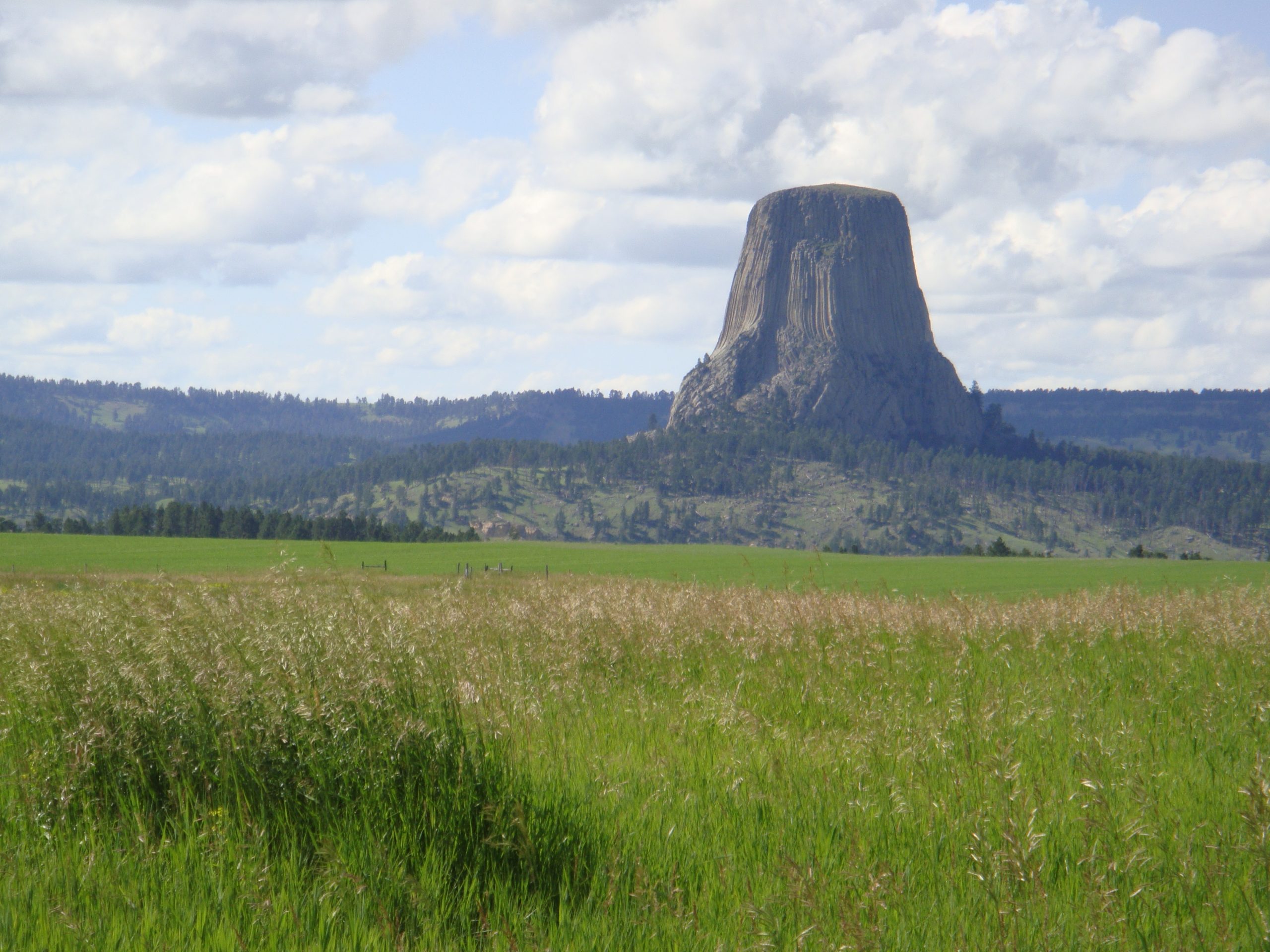
STUDENT LEARNING OUTCOMES
At the end of this chapter, students should be able to:
- Contrast objective versus subjective observations, and quantitative versus qualitative observations
- Identify a pseudoscience based on its lack of falsifiability
- Contrast the methods used by Aristotle and Galileo to describe the natural environment
- Explain the scientific method and apply it to a problem or question
- Describe the foundations of modern geology, such as the principle of uniformitarianism
- Contrast uniformitarianism with catastrophism
- Explain why studying geology is important
- Identify how Earth materials are transformed by rock cycle processes
- Describe the steps involved in a reputable scientific study
- Explain rhetorical arguments used by science deniers
1.1 What is Science?
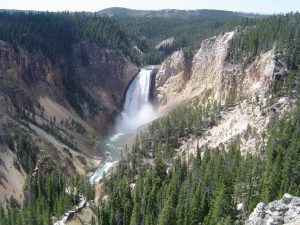
Scientists seek to understand the fundamental principles that explain natural patterns and processes. Science is more than just a body of knowledge, science provides a means to evaluate and create new knowledge without bias. Scientists use objective evidence over subjective evidence, to reach sound and logical conclusions.
An objective observation is without personal bias and the same by all individuals. Humans are biased by nature, so they cannot be completely objective ; the goal is to be as unbiased as possible. A subjective observation is based on a person’s feelings and beliefs and is unique to that individual.
Another way scientists avoid bias is by using quantitative over qualitative measurements whenever possible. A quantitative measurement is expressed with a specific numerical value. Qualitative observations are general or relative descriptions. For example, describing a rock as red or heavy is a qualitative observation . Determining a rock’s color by measuring wavelengths of reflected light or its density by measuring the proportions of minerals it contains is quantitative . Numerical values are more precise than general descriptions, and they can be analyzed using statistical calculations. This is why quantitative measurements are much more useful to scientists than qualitative observations.
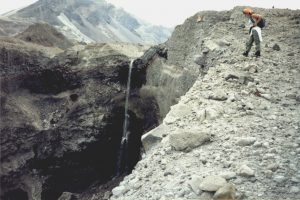
Establishing truth in science is difficult because all scientific claims are falsifiable , which means any initial hypothesis may be tested and proven false. Only after exhaustively eliminating false results, competing ideas, and possible variations does a hypothesis become regarded as a reliable scientific theory . This meticulous scrutiny reveals weaknesses or flaws in a hypothesis and is the strength that supports all scientific ideas and procedures. In fact, proving current ideas are wrong has been the driving force behind many scientific careers.
Falsifiability separates science from pseudoscience . Scientists are wary of explanations of natural phenomena that discourage or avoid falsifiability. An explanation that cannot be tested or does not meet scientific standards is not considered science, but pseudoscience . Pseudoscience is a collection of ideas that may appear scientific but does not use the scientific method . Astrology is an example of pseudoscience . It is a belief system that attributes the movement of celestial bodies to influencing human behavior. Astrologers rely on celestial observations, but their conclusions are not based on experimental evidence and their statements are not falsifiable . This is not to be confused with astronomy which is the scientific study of celestial bodies and the cosmos .
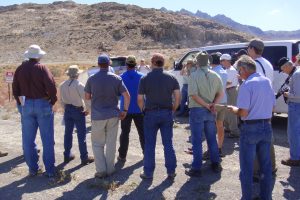
Science is also a social process. Scientists share their ideas with peers at conferences, seeking guidance and feedback. Research papers and data submitted for publication are rigorously reviewed by qualified peers, scientists who are experts in the same field. The scientific review process aims to weed out misinformation, invalid research results, and wild speculation. Thus, it is slow, cautious, and conservative. Scientists tend to wait until a hypothesis is supported by overwhelming amount of evidence from many independent researchers before accepting it as scientific theory .
Take this quiz to check your comprehension of this section.

1.2 The Scientific Method
Modern science is based on the scientific method , a procedure that follows these steps:
- Formulate a question or observe a problem
- Apply objective experimentation and observation
- Analyze collected data and Interpret results
- Devise an evidence-based theory
- Submit findings to peer review and/or publication
This has a long history in human thought but was first fully formed by Ibn al-Haytham over 1,000 years ago. At the forefront of the scientific method are conclusions based on objective evidence, not opinion or hearsay .
Step One: Observation, Problem, or Research Question
The procedure begins with identifying a problem or research question, such as a geological phenomenon that is not well explained in the scientific community’s collective knowledge. This step usually involves reviewing the scientific literature to understand previous studies that may be related to the question.
Step Two: Hypothesis

Once the problem or question is well defined, the scientist proposes a possible answer, a hypothesis , before conducting an experiment or field work. This hypothesis must be specific, falsifiable , and should be based on other scientific work. Geologists often develop multiple working hypotheses because they usually cannot impose strict experimental controls or have limited opportunities to visit a field location.
Step Three: Experiment and Hypothesis Revision

The next step is developing an experiment that either supports or refutes the hypothesis . Many people mistakenly think experiments are only done in a lab; however, an experiment can consist of observing natural processes in the field. Regardless of what form an experiment takes, it always includes the systematic gathering of objective data. This data is interpreted to determine whether it contradicts or supports the hypothesis , which may be revised and tested again. When a hypothesis holds up under experimentation, it is ready to be shared with other experts in the field.
Step Four: Peer Review, Publication, and Replication
Scientists share the results of their research by publishing articles in scientific journals, such as Science and Nature . Reputable journals and publishing houses will not publish an experimental study until they have determined its methods are scientifically rigorous and the conclusions are supported by evidence. Before an article is published, it undergoes a rigorous peer review by scientific experts who scrutinize the methods, results, and discussion. Once an article is published, other scientists may attempt to replicate the results. This replication is necessary to confirm the reliability of the study’s reported results. A hypothesis that seemed compelling in one study might be proven false in studies conducted by other scientists. New technology can be applied to published studies, which can aid in confirming or rejecting once-accepted ideas and/or hypotheses .
Step Five: Theory Development
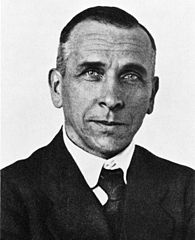
In casual conversation, the word theory implies guesswork or speculation. In the language of science, an explanation or conclusion made in a theory carries much more weight because it is supported by experimental verification and widely accepted by the scientific community. After a hypothesis has been repeatedly tested for falsifiability through documented and independent studies, it eventually becomes accepted as a scientific theory .
While a hypothesis provides a tentative explanation before an experiment , a theory is the best explanation after being confirmed by multiple independent experiments. Confirmation of a theory may take years, or even longer. For example, the continental drift hypothesis first proposed by Alfred Wegener in 1912 was initially dismissed. After decades of additional evidence collection by other scientists using more advanced technology, Wegener’s hypothesis was accepted and revised as the theory of plate tectonics .
The theory of evolution by natural selection is another example. Originating from the work of Charles Darwin in the mid-19th century, the theory of evolution has withstood generations of scientific testing for falsifiability. While it has been updated and revised to accommodate knowledge gained by using modern technologies, the theory of evolution continues to be supported by the latest evidence.

1.3 Early Scientific Thought

Western scientific thought began in the ancient city of Athens, Greece. Athens was governed as a democracy, which encouraged individuals to think independently, at a time when most civilizations were ruled by monarchies or military conquerors. Foremost among the early philosopher/scientists to use empirical thinking was Aristotle, born in 384 BCE. Empiricism emphasizes the value of evidence gained from experimentation and observation . Aristotle studied under Plato and tutored Alexander the Great. Alexander would later conquer the Persian Empire, and in the process spread Greek culture as far east as India.
Aristotle applied an empirical method of analysis called deductive reasoning , which applies known principles of thought to establish new ideas or predict new outcomes. Deductive reasoning starts with generalized principles and logically extends them to new ideas or specific conclusions. If the initial principle is valid, then it is highly likely the conclusion is also valid. An example of deductive reasoning is if A=B, and B=C, then A=C. Another example is if all birds have feathers, and a sparrow is a bird, then a sparrow must also have feathers. The problem with deductive reasoning is if the initial principle is flawed, the conclusion will inherit that flaw. Here is an example of a flawed initial principle leading to the wrong conclusion; if all animals that fly are birds, and bats also fly, then bats must also be birds.
This type of empirical thinking contrasts with inductive reasoning , which begins from new observations and attempts to discern underlying generalized principles. A conclusion made through inductive reasoning comes from analyzing measurable evidence, rather making a logical connection. For example, to determine whether bats are birds a scientist might list various characteristics observed in birds–the presence of feathers, a toothless beak, hollow bones, lack of forelegs, and externally laid eggs. Next, the scientist would check whether bats share the same characteristics, and if they do not, draw the conclusion that bats are not birds.
Both types of reasoning are important in science because they emphasize the two most important aspects of science: observation and inference. Scientists test existing principles to see if they accurately infer or predict their observations. They also analyze new observations to determine if the inferred underlying principles still support them.

Greek culture was spread by Alexander and then absorbed by the Romans, who help further extend Greek knowledge into Europe through their vast infrastructure of roads, bridges, and aqueducts. After the fall of the Roman Empire in 476 CE, scientific progress in Europe stalled. Scientific thinkers of medieval time had such high regard for Aristotle’s wisdom and knowledge they faithfully followed his logical approach to understanding nature for centuries. By contrast, science in the Middle East flourished and grew between 800 and 1450 CE, along with culture and the arts.
Near the end of the medieval period , empirical experimentation became more common in Europe. During the Renaissance, which lasted from the 14 th through 17 th centuries, artistic and scientific thought experienced a great awakening. European scholars began to criticize the traditional Aristotelian approach and by the end of the Renaissance period , empiricism was poised to become a key component of the scientific revolution that would arise in the 17 th century.

An early example of how Renaissance scientists began to apply a modern empirical approach is their study of the solar system . In the second century, the Greek astronomer Claudius Ptolemy observed the Sun, Moon, and stars moving across the sky. Applying Aristotelian logic to his astronomical calculations, he deductively reasoned all celestial bodies orbited around the Earth, which was located at the center of the universe. Ptolemy was a highly regarded mathematician, and his mathematical calculations were widely accepted by the scientific community. The view of the cosmos with Earth at its center is called the geocentric model. This geocentric model persisted until the Renaissance period , when some revolutionary thinkers challenged the centuries-old hypothesis .
By contrast, early Renaissance scholars such as astronomer Nicolaus Copernicus (1473-1543) proposed an alternative explanation for the perceived movement of the Sun, Moon, and stars. Sometime between 1507 and 1515, he provided credible mathematical proof for a radically new model of the cosmos, one in which the Earth and other planets orbited around a centrally located Sun. After the invention of the telescope in 1608, scientists used their enhanced astronomical observations to support this heliocentric, Sun-centered, model.
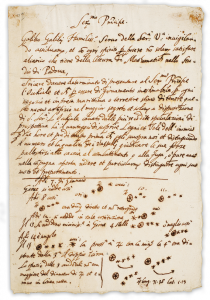
Two scientists, Johannes Kepler and Galileo Galilei, are credited with jump-starting the scientific revolution. They accomplished this by building on Copernicus work and challenging long-established ideas about nature and science.
Johannes Kepler (1571-1630) was a German mathematician and astronomer who expanded on the heliocentric model—improving Copernicus’ original calculations and describing planetary motion as elliptical paths. Galileo Galilei (1564 – 1642) was an Italian astronomer who used the newly developed telescope to observe the four largest moons of Jupiter. This was the first piece of direct evidence to contradict the geocentric model, since moons orbiting Jupiter could not also be orbiting Earth.
Galileo strongly supported the heliocentric model and attacked the geocentric model, arguing for a more scientific approach to determine the credibility of an idea. Because of this he found himself at odds with prevailing scientific views and the Catholic Church. In 1633 he was found guilty of heresy and placed under house arrest, where he would remain until his death in 1642.
Galileo is regarded as the first modern scientist because he conducted experiments that would prove or disprove falsifiable ideas and based his conclusions on mathematical analysis of quantifiable evidence—a radical departure from the deductive thinking of Greek philosophers such as Aristotle . His methods marked the beginning of a major shift in how scientists studied the natural world, with an increasing number of them relying on evidence and experimentation to form their hypotheses . It was during this revolutionary time that geologists such as James Hutton and Nicolas Steno also made great advances in their scientific fields of study.

1.4 Foundations of Modern Geology

As part of the scientific revolution in Europe, modern geologic principles developed in the 17th and 18th centuries. One major contributor was Nicolaus Steno (1638-1686), a Danish priest who studied anatomy and geology. Steno was the first to propose the Earth’s surface could change over time. He suggested sedimentary rocks, such as sandstone and shale , originally formed in horizontal layers with the oldest on the bottom and progressively younger layers on top.
In the 18th century, Scottish naturalist James Hutton (1726–1797) studied rivers and coastlines and compared the sediments they left behind to exposed sedimentary rock strata. He hypothesized the ancient rocks must have been formed by processes like those producing the features in the oceans and streams . Hutton also proposed the Earth was much older than previously thought. Modern geologic processes operate slowly. Hutton realized if these processes formed rocks, then the Earth must be very old, possibly hundreds of millions of years old.
Hutton’s idea is called the principle of uniformitarianism and states that natural processes operate the same now as in the past, i.e. the laws of nature are uniform across space and time. Geologist often state “the present is the key to the past,” meaning they can understand ancient rocks by studying modern geologic processes.
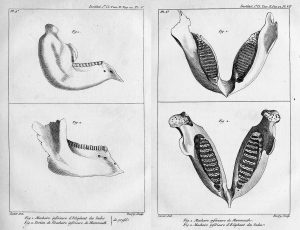
Prior to the acceptance of uniformitarianism , scientists such as German geologist Abraham Gottlob Werner (1750-1817) and French anatomist Georges Cuvier (1769-1832) thought rocks and landforms were formed by great catastrophic events. Cuvier championed this view, known as catastrophism , and stated, “The thread of operation is broken; nature has changed course, and none of the agents she employs today would have been sufficient to produce her former works.” He meant processes that operate today did not operate in the past. Known as the father of vertebrate paleontology, Cuvier made significant contributions to the study of ancient life and taught at Paris’s Museum of Natural History. Based on his study of large vertebrate fossils , he was the first to suggest species could go extinct . However, he thought new species were introduced by special creation after catastrophic floods.
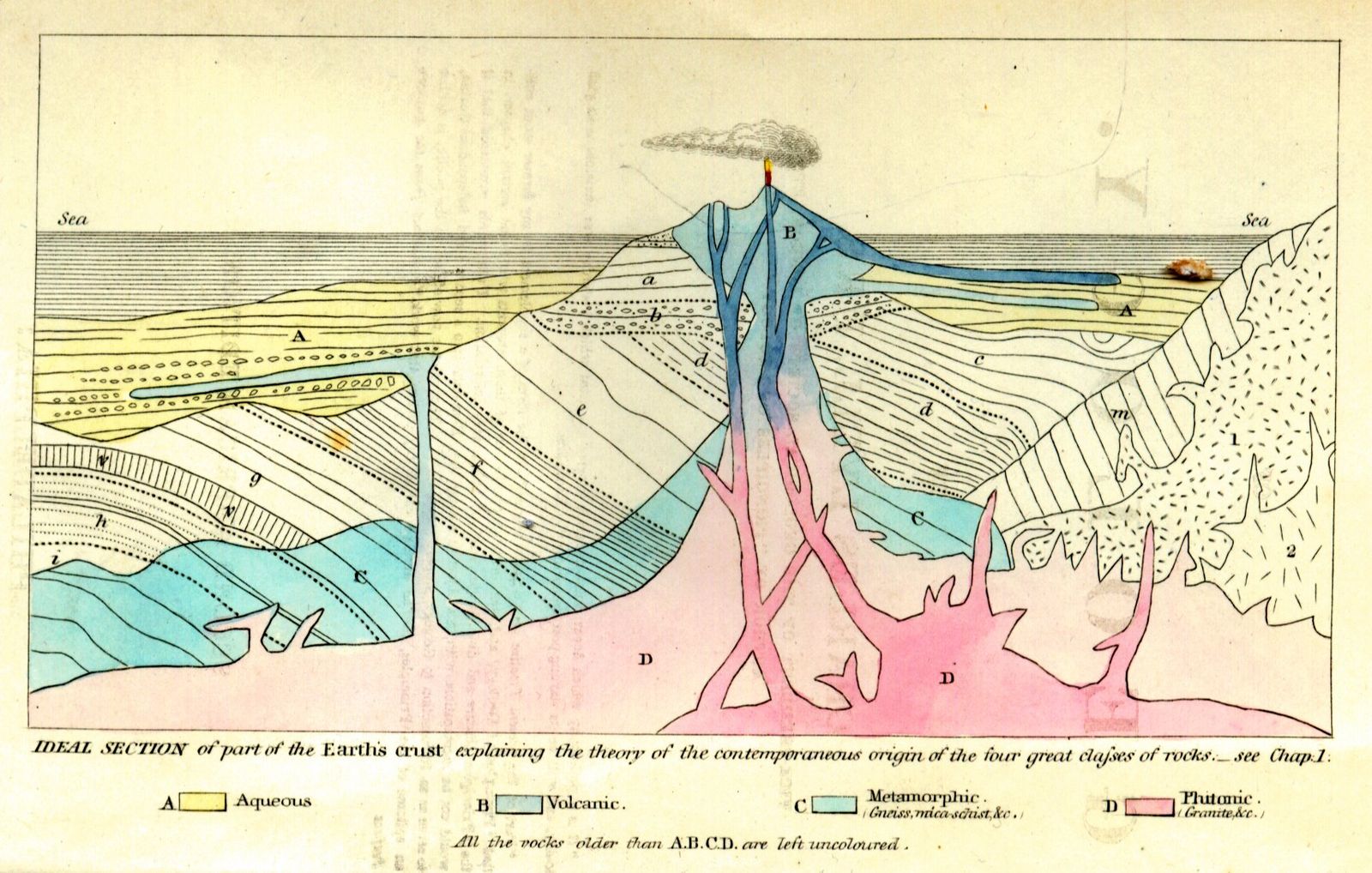
Hutton’s ideas about uniformitarianism and Earth’s age were not well received by the scientific community of his time. His ideas were falling into obscurity when Charles Lyell, a British lawyer and geologist (1797-1875), wrote the Principles of Geology in the early 1830s and later, Elements of Geology . Lyell’s books promoted Hutton’s principle of uniformitarianism , his studies of rocks and the processes that formed them, and the idea that Earth was possibly over 300 million years old. Lyell and his three-volume Principles of Geology had a lasting influence on the geologic community and public at large, who eventually accepted uniformitarianism and millionfold age for the Earth. The principle of uniformitarianism became so widely accepted, that geologists regarded catastrophic change as heresy. This made it harder for ideas like the sudden demise of the dinosaurs by asteroid impact to gain traction.
A contemporary of Lyell, Charles Darwin (1809-1882) took Principles of Geology on his five-year trip on the HMS Beagle. Darwin used uniformitarianism and deep geologic time to develop his initial ideas about evolution. Lyell was one of the first to publish a reference to Darwin’s idea of evolution.
The next big advancement, and perhaps the largest in the history of geology, is the theory of plate tectonics and continental drift. Dogmatic acceptance of uniformitarianism inhibited the progress of this idea, mainly because of the permanency placed on the continents and their positions. Ironically, slow and steady movement of plates would fit well into a uniformitarianism model. However, much time passed and a great deal of scientific resistance had to be overcome before the idea took hold. This happened for several reasons. Firstly, the movement was so slow it was overlooked. Secondly, the best evidence was hidden under the ocean. Finally, the accepted theories were anchored by a large amount of inertia. Instead of being bias free, scientists resisted and ridiculed the emerging idea of plate tectonics . This example of dogmatic thinking is still to this day a tarnish on the geoscience community.

Plate tectonics is most commonly attributed to Alfred Wegener, the first scientist to compile a large data set supporting the idea of continents shifting places over time. He was mostly ignored and ridiculed for his ideas, but later workers like Marie Tharp, Bruce Heezen, Harry Hess, Laurence Morley, Frederick Vine, Drummond Matthews, Kiyoo Wadati, Hugo Benioff, Robert Coats, and J. Tuzo Wilson benefited from advances in sub-sea technologies. They discovered, described, and analyzed new features like the mid-ocean ridge , alignment of earthquakes, and magnetic striping . Gradually these scientists introduced a paradigm shift that revolutionized geology into the science we know today.

1.5 The Study of Geology
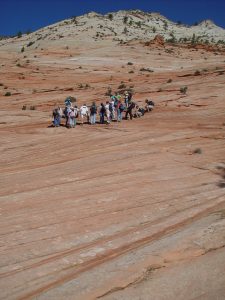
Geologists apply the scientific method to learn about Earth’s materials and processes. Geology plays an important role in society; its principles are essential to locating, extracting, and managing natural resources ; evaluating environmental impacts of using or extracting these resources; as well as understanding and mitigating the effects of natural hazards.
Geology often applies information from physics and chemistry to the natural world, like understanding the physical forces in a landslide or the chemical interaction between water and rocks. The term comes from the Greek word geo , meaning Earth, and logos , meaning to think or reckon with.
1.5.1 Why Study Geology?
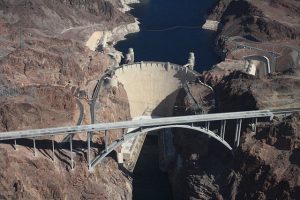
Geology plays a key role in how we use natural resources —any naturally occurring material that can be extracted from the Earth for economic gain. Our developed modern society, like all societies before it, is dependent on geologic resources. Geologists are involved in extracting fossil fuels , such as coal and petroleum ; metals such as copper, aluminum, and iron; and water resources in streams and underground reservoirs inside soil and rocks. They can help conserve our planet’s finite supply of nonrenewable resources, like petroleum , which are fixed in quantity and depleted by consumption. Geologists can also help manage renewable resources that can be replaced or regenerated, such as solar or wind energy, and timber.
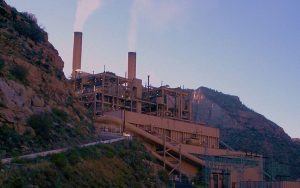
Resource extraction and usage impacts our environment, which can negatively affect human health. For example, burning fossil fuels releases chemicals into the air that are unhealthy for humans, especially children. Mining activities can release toxic heavy metals, such as lead and mercury, into the soil and waterways. Our choices will have an effect on Earth’s environment for the foreseeable future. Understanding the remaining quantity, extractability, and renewability of geologic resources will help us better sustainably manage those resources.

Geologists also study natural hazards created by geologic processes. Natural hazards are phenomena that are potentially dangerous to human life or property. No place on Earth is completely free of natural hazards, so one of the best ways people can protect themselves is by understanding geology. Geology can teach people about the natural hazards in an area and how to prepare for them. Geologic hazards include landslides , earthquakes, tsunamis , floods, volcanic eruptions, and sea-level rise.
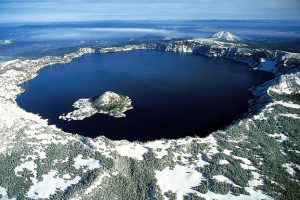
Finally, geology is where other scientific disciplines intersect in the concept known as Earth System Science . In science, a system is a group of interactive objects and processes. Earth System Science views the entire planet as a combination of systems that interact with each other via complex relationships. This geology textbook provides an introduction to science in general and will often reference other scientific disciplines.
Earth System Science includes five basic systems (or spheres), the Geosphere (the solid body of the Earth), the Atmosphere (the gas envelope surrounding the Earth), the Hydrosphere (water in all its forms at and near the surface of the Earth), the Cryosphere (frozen water part of Earth), and the Biosphere (life on Earth in all its forms and interactions, including humankind).
Rather than viewing geology as an isolated system , earth system scientists study how geologic processes shape not only the world, but all the spheres it contains. They study how these multidisciplinary spheres relate, interact, and change in response to natural cycles and human-driven forces. They use elements from physics, chemistry, biology, meteorology, environmental science, zoology, hydrology, and many other sciences.
1.5.2 Rock Cycle
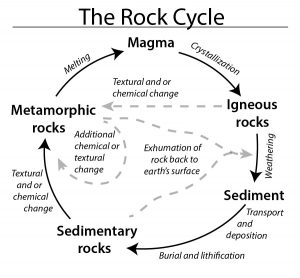
The most fundamental view of Earth materials is the rock cycle , which describes the major materials that comprise the Earth, the processes that form them, and how they relate to each other. It usually begins with hot molten liquid rock called magma or lava . Magma forms under the Earth’s surface in the crust or mantle . Lava is molten rock that erupts onto the Earth’s surface. When magma or lava cools, it solidifies by a process called crystallization in which minerals grow within the magma or lava . The rocks resulting rocks are igneous rocks. I gnis is Latin for fire.
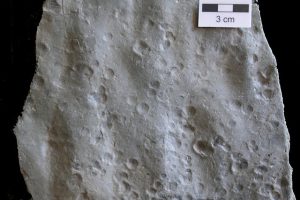
Igneous rocks, as well as other types of rocks, on Earth’s surface are exposed to weathering and erosion , which produces sediments . Weathering is the physical and chemical breakdown of rocks into smaller fragments. Erosion is the removal of those fragments from their original location. The broken-down and transported fragments or grains are considered sediments , such as gravel, sand, silt, and clay. These sediments may be transported by streams and rivers , ocean currents, glaciers , and wind.
Sediments come to rest in a process known as deposition . As the deposited sediments accumulate—often under water, such as in a shallow marine environment—the older sediments get buried by the new deposits. The deposits are compacted by the weight of the overlying sediments and individual grains are cemented together by minerals in groundwater . These processes of compaction and cementation are called lithification . Lithified sediments are considered a sedimentary rock , such as sandstone and shale . Other sedimentary rocks are made by direct chemical precipitation of minerals rather than eroded sediments , and are known as chemical sedimentary rocks.
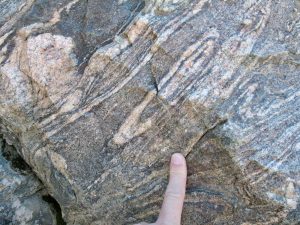
Pre-existing rocks may be transformed into a metamorphic rock ; meta- means change and -morphos means form or shape. When rocks are subjected to extreme increases in temperature or pressure, the mineral crystals are enlarged or altered into entirely new minerals with similar chemical make up. High temperatures and pressures occur in rocks buried deep within the Earth’s crust or that come into contact with hot magma or lava . If the temperature and pressure conditions melt the rocks to create magma and lava , the rock cycle begins anew with the creation of new rocks.
1.5.3 Plate Tectonics and Layers of Earth
The theory of plate tectonics is the fundamental unifying principle of geology and the rock cycle . Plate tectonics describes how Earth’s layers move relative to each other, focusing on the tectonic or lithospheric plates of the outer layer. Tectonic plates float, collide, slide past each other, and split apart on an underlying mobile layer called the asthenosphere . Major landforms are created at the plate boundaries, and rocks within the tectonic plates move through the rock cycle . Plate tectonics is discussed in more detail in Chapter 2 .
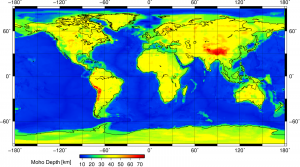
Earth’s three main geological layers can be categorized by chemical composition or the chemical makeup: crust , mantle , and core . The crust is the outermost layer and composed of mostly silicon, oxygen, aluminum, iron, and magnesium. There are two types, continental crust and oceanic crust . Continental crust is about 50 km (30 mi) thick, composed of low-density igneous and sedimentary rocks, Oceanic crust is approximately 10 km (6 mi) thick and made of high-density igneous basalt -type rocks. Oceanic crust makes up most of the ocean floor , covering about 70% of the planet. Tectonic plates are made of crust and a portion the upper mantle , forming a rigid physical layer called the lithosphere .
The mantle , the largest chemical layer by volume, lies below the crust and extends down to about 2,900 km (1,800 mi) below the Earth’s surface. The mostly solid mantle is made of peridotite , a high-density composed of silica, iron, and magnesium. The upper part of mantel is very hot and flexible, which allows the overlying tectonic plates to float and move about on it. Under the mantle is the Earth’s core , which is 3,500 km (2,200 mi) thick and made of iron and nickel. The core consists of two parts, a liquid outer core and solid inner core . Rotations within the solid and liquid metallic core generate Earth’s magnetic field (see figure).
1.5.4 Geologic Time and Deep Time
Geologic time on Earth, represented circularly, to show the individual time divisions and important events. Ga=billion years ago, Ma=million years ago. “The result, therefore, of our present enquiry is, that we find no vestige of a beginning; no prospect of an end.” (James Hutton, 1788)
One of the early pioneers of geology, James Hutton, wrote this about the age of the Earth after many years of geological study. Although he wasn’t exactly correct—there is a beginning and will be an end to planet Earth—Hutton was expressing the difficulty humans have in perceiving the vastness of geological time. Hutton did not assign an age to the Earth, although he was the first to suggest the planet was very old. Today we know Earth is approximately 4.54 ± 0.05 billion years old. This age was first calculated by Caltech professor Clair Patterson in 1956, who measured the half-lives of lead isotopes to radiometrically date a meteorite recovered in Arizona. Studying geologic time, also known as deep time, can help us overcome a perspective of Earth that is limited to our short lifetimes. Compared to the geologic scale, the human lifespan is very short, and we struggle to comprehend the depth of geologic time and slowness of geologic processes. For example, the study of earthquakes only goes back about 100 years; however, there is geologic evidence of large earthquakes occurring thousands of years ago. And scientific evidence indicates earthquakes will continue for many centuries into the future.
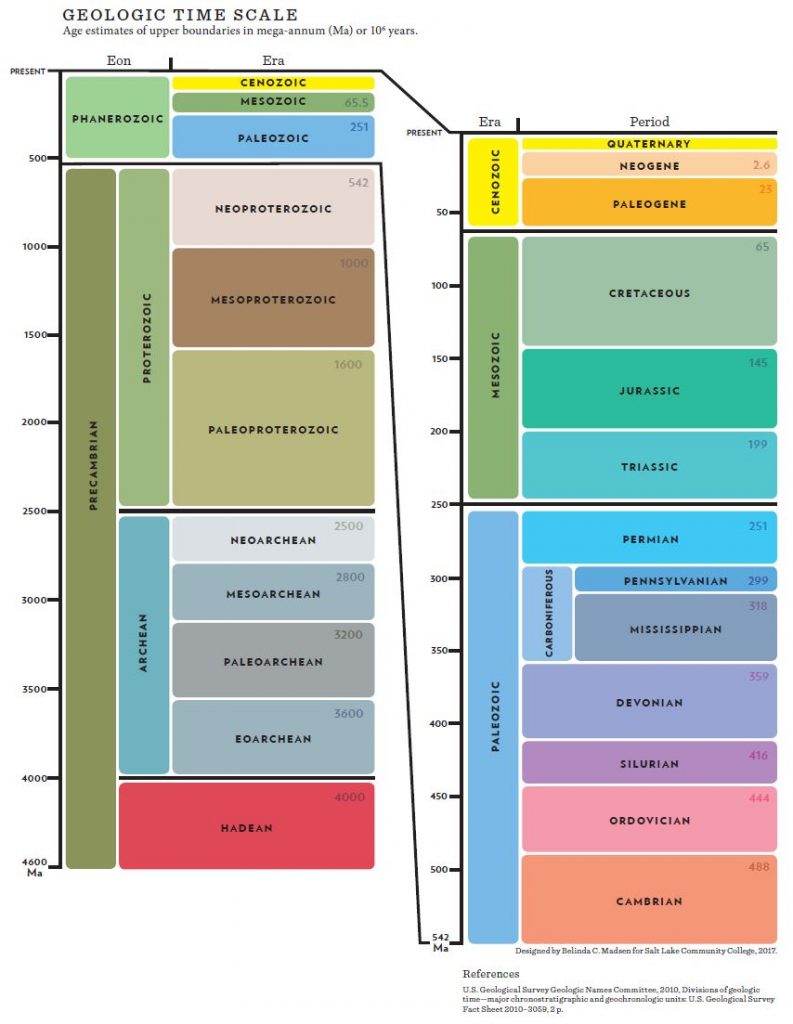
Eons are the largest divisions of time, and from oldest to youngest are named Hadean , Archean , Proterozoic , and Phanerozoic . The three oldest eons are sometimes collectively referred to as Precambrian time.
Life first appeared more than 3,800 million of years ago (Ma). From 3,500 Ma to 542 Ma, or 88% of geologic time, the predominant life forms were single-celled organisms such as bacteria. More complex organisms appeared only more recently, during the current Phanerozoic Eon , which includes the last 542 million years or 12% of geologic time.
The name Phanerozoic comes from phaneros , which means visible, and zoic , meaning life. This eon marks the proliferation of multicellular animals with hard body parts, such as shells, which are preserved in the geological record as fossils . Land-dwelling animals have existed for 360 million years, or 8% of geologic time. The demise of the dinosaurs and subsequent rise of mammals occurred around 65 Ma, or 1.5% of geologic time. Our human ancestors belonging to the genus Homo have existed since approximately 2.2 Ma—0.05% of geological time or just 1/2,000th the total age of Earth.
The Phanerozoic Eon is divided into three eras : Paleozoic , Mesozoic , and Cenozoic . Paleozoic means ancient life , and organisms of this era included invertebrate animals, fish, amphibians, and reptiles. The Mesozoic ( middle life ) is popularly known as the Age of Reptiles and is characterized by the abundance of dinosaurs, many of which evolved into birds. The mass extinction of the dinosaurs and other apex predator reptiles marked the end of the Mesozoic and beginning of the Cenozoic . Cenozoic means new life and is also called the Age of Mammals, during which mammals evolved to become the predominant land-dwelling animals. Fossils of early humans, or hominids, appear in the rock record only during the last few million years of the Cenozoic . The geologic time scale, geologic time, and geologic history are discussed in more detail in chapters 7 and 8 .
1.5.5 The Geologist’s Tools
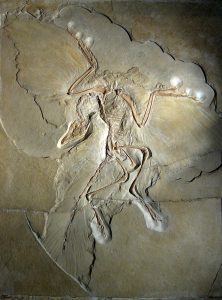
In its simplest form, a geologist’s tool may be a rock hammer used for sampling a fresh surface of a rock. A basic tool set for fieldwork might also include:
- Magnifying lens for looking at mineralogical details
- Compass for measuring the orientation of geologic features
- Map for documenting the local distribution of rocks and minerals
- Magnet for identifying magnetic minerals like magnetite
- Dilute solution of hydrochloric acid to identify carbonate -containing minerals like calcite or limestone .
In the laboratory, geologists use optical microscopes to closely examine rocks and soil for mineral composition and grain size . Laser and mass spectrometers precisely measure the chemical composition and geological age of minerals . Seismographs record and locate earthquake activity, or when used in conjunction with ground penetrating radar, locate objects buried beneath the surface of the earth. Scientists apply computer simulations to turn their collected data into testable, theoretical models. Hydrogeologists drill wells to sample and analyze underground water quality and availability. Geochemists use scanning electron microscopes to analyze minerals at the atomic level, via x-rays. Other geologists use gas chromatography to analyze liquids and gases trapped in glacial ice or rocks.
Technology provides new tools for scientific observation , which leads to new evidence that helps scientists revise and even refute old ideas. Because the ultimate technology will never be discovered, the ultimate observation will never be made. And this is the beauty of science—it is ever-advancing and always discovering something new.

1.6 Science Denial and Evaluating Sources

Introductory science courses usually deal with accepted scientific theory and do not include opposing ideas, even though these alternate ideas may be credible. This makes it easier for students to understand the complex material. Advanced students will encounter more controversies as they continue to study their discipline.
Some groups of people argue that some established scientific theories are wrong, not based on their scientific merit but rather on the ideology of the group. This section focuses on how to identify evidence based information and differentiate it from pseudoscience .
1.6.1 Science Denial
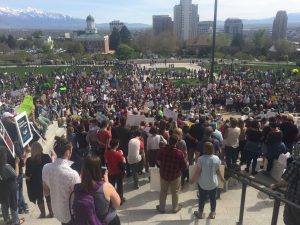
Science denial happens when people argue that established scientific theories are wrong, not based on scientific merit but rather on subjective ideology—such as for social, political, or economic reasons. Organizations and people use science denial as a rhetorical argument against issues or ideas they oppose. Three examples of science denial versus science are: 1) teaching evolution in public schools, 2) linking tobacco smoke to cancer, and 3) linking human activity to climate change. Among these, denial of climate change is strongly connected with geology. A climate denier specifically denies or doubts the objective conclusions of geologists and climate scientists.
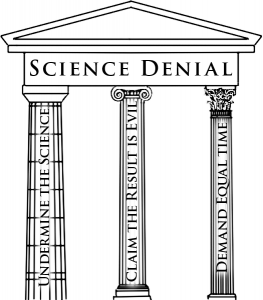
Science denial generally uses three false arguments. The first argument tries to undermine the credibility of the scientific conclusion by claiming the research methods are flawed or the theory is not universally accepted—the science is unsettled. The notion that scientific ideas are not absolute creates doubt for non-scientists; however, a lack of universal truths should not be confused with scientific uncertainty. Because science is based on falsfiabiity, scientists avoid claiming universal truths and use language that conveys uncertainty. This allows scientific ideas to change and evolve as more evidence is uncovered.
The second argument claims the researchers are not objective and motivated by an ideology or economic agenda. This is an ad hominem argument in which a person’s character is attacked instead of the merit of their argument. They claim results have been manipulated so researchers can justify asking for more funding. They claim that because the researchers are funded by a federal grant, they are using their results to lobby for expanded government regulation.
The third argument is to demand a balanced view, equal time in media coverage and educational curricula, to engender the false illusion of two equally valid arguments. Science deniers frequently demand equal coverage of their proposals, even when there is little scientific evidence supporting their ideology. For example, science deniers might demand religious explanations be taught as an alternative to the well-established theory of evolution [zotpressInText item=”{X9U8B54N},{W934C3CR}” format=”%num%” brackets=”yes”] . Or that all possible causes of climate change be discussed as equally probable, regardless of the body of evidence. Conclusions derived using the scientific method should not be confused with those based on ideologies.
Furthermore, conclusions about nature derived from ideologies have no place in science research and education. For example, it would be inappropriate to teach the flat earth model in a modern geology course because this idea has been disproved by the scientific method . Unfortunately, widespread scientific illiteracy allows these arguments to be used to suppress scientific knowledge and spread misinformation.
The formation of new conclusions based on the scientific method is the only way to change scientific conclusions. We wouldn’t teach Flat Earth geology along with plate tectonics because Flat Earthers don’t follow the scientific method . The fact that scientists avoid universal truths and change their ideas as more evidence is uncovered shouldn’t be seen as meaning that the science is unsettled. Because of widespread scientific illiteracy, these arguments are used by those who wish to suppress science and misinform the general public.
In a classic case of science denial , beginning in the 1960s and for the next three decades, the tobacco industry and their scientists used rhetorical arguments to deny a connection between tobacco usage and cancer. Once it became clear scientific studies overwhelmingly found that using tobacco dramatically increased a person’s likelihood of getting cancer, their next strategy was to create a sense of doubt about on the science. The tobacco industry suggested the results were not yet fully understood and more study was needed. They used this doubt to lobby for delaying legislative action that would warn consumers of the potential health hazards [zotpressInText item=”{X9U8B54N},{CBD5438R}” format=”%num%” brackets=”yes”] . This same tactic is currently being employed by those who deny the significance of human involvement in climate change.
1.6.2 Evaluating Sources of Information
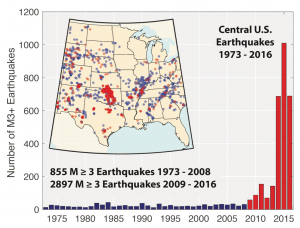
In the age of the internet, information is plentiful. Geologists, scientists, or anyone exploring scientific inquiry must discern valid sources of information from pseudoscience and misinformation. This evaluation is especially important in scientific research because scientific knowledge is respected for its reliability. Textbooks such as this one can aid this complex and crucial task. At its roots, quality information comes from the scientific method , beginning with the empirical thinking of Aristotle. The application of the scientific method helps produce unbiased results. A valid inference or interpretation is based on objective evidence or data. Credible data and inferences are clearly labeled, separated, and differentiated. Anyone looking over the data can understand how the author’s conclusion was derived or come to an alternative conclusion. Scientific procedures are clearly defined so the investigation can be replicated to confirm the original results or expanded further to produce new results. These measures make a scientific inquiry valid and its use as a source reputable. Of course, substandard work occasionally slips through and retractions are published from time to time. An infamous article linking the MMR vaccine to autism appeared in the highly reputable journal Lancet in 1998. Journalists discovered the author had multiple conflicts of interest and fabricated data, and the article was retracted in 2010.
In addition to methodology, data, and results, the authors of a study should be investigated. When looking into any research, the author(s) should be investigated. An author’s credibility is based on multiple factors, such as having a degree in a relevant topic or being funded from an unbiased source.
The same rigor should be applied to evaluating the publisher, ensuring the results reported come from an unbiased process. The publisher should be easy to discover. Good publishers will show the latest papers in the journal and make their contact information and identification clear. Reputable journals show their peer review style. Some journal are predatory, where they use unexplained and unnecessary fees to submit and access journals. Reputable journals have recognizable editorial boards. Often, a reliable journal will associate with a trade, association, or recognized open source initiative.
One of the hallmarks of scientific research is peer review . Research should be transparent to peer review . This allows the scientific community to reproduce experimental results, correct and retract errors, and validate theories. This allows reproduction of experimental results, corrections of errors, and proper justification of the research to experts.
Citation is not only imperative to avoid plagiarism, but also allows readers to investigate an author’s line of thought and conclusions. When reading scientific works, it is important to confirm the citations are from reputable scientific research. Most often, scientific citations are used to reference paraphrasing rather than quotes. The number of times a work is cited is said to measure of the influence an investigation has within the scientific community, although this technique is inherently biased.

Science is a process, with no beginning and no end. Science is never finished because a full truth can never be known. However, science and the scientific method are the best way to understand the universe we live in. Scientists draw conclusions based on objective evidence; they consolidate these conclusions into unifying models. Geologists likewise understand studying the Earth is an ongoing process, beginning with James Hutton who declared the Earth has “…no vestige of a beginning, no prospect of an end.” Geologists explore the 4.5 billion-year history of Earth, its resources, and its many hazards. From a larger viewpoint, geology can teach people how to develop credible conclusions, as well as identify and stop misinformation.
Take this quiz to check your comprehension of this chapter.

- Adams, F.D., 1954, The birth and development of the geological sciences
- Alfe, D., Gillan, M.J., and Price, G.D., 2002, Composition and temperature of the Earth’s core constrained by combining ab initio calculations and seismic data: Earth Planet. Sci. Lett., v. 195, no. 1, p. 91–98.
- Alkin, M.C., 2004, Evaluation Roots: Tracing theorists’ views and influences: SAGE.
- Beckwith, C., 2013, How western Europe developed a full scientific method: Berfrois.
- Birch, F., 1952, Elasticity and constitution of the Earth’s interior: J. Geophys. Res., v. 57, no. 2, p. 227–286., doi: 10.1029/JZ057i002p00227 .
- Bocking, S., 2004, Nature’s experts: science, politics, and the environment: Rutgers University Press.
- Chamberlin, T.C., 1890, The method of multiple working hypotheses: Science, v. 15, no. 366, p. 92–96.
- Cohen, H.F., 2010, How modern science came into the world: Four civilizations, one 17th-century breakthrough: Amsterdam University Press.
- Darwin, C., 1846, Geological Observations on South America: Being the Third Part of the Geology of the Voyage of the Beagle, Under the Command of Capt. Fitzroy, R.N. During the Years 1832 to 1836: Smith, Elder and Company.
- Drake, S., 1990, Galileo: Pioneer Scientist: University of Toronto Press.
- Engdahl, E.R., Flynn, E.A., and Masse, R.P., 1974, Differential PkiKP travel times and the radius of the core: Geophysical J Royal Astro Soc, v. 40, p. 457–463.
- Everitt, A., 2016, The Rise of Athens: The Story of the World’s Greatest Civilization:
- Goldstein, B.R., 2002, Copernicus and the origin of his heliocentric system: Journal for the History of Astronomy, v. 33, p. 219–235.
- Goldsworthy, A.K., 2011, The complete Roman army: Thames & Hudson.
- Hans Wedepohl, K., 1995, The composition of the continental crust: Geochim. Cosmochim. Acta, v. 59, no. 7, p. 1217–1232.
- Heilbron, J.L., 2012, Galileo: Oxford, Oxford University Press, 528 p.
- Hogendijk, J.P., and Sabra, A.I., 2003, The Enterprise of Science in Islam: New Perspectives: MIT Press.
- Jakosky, B.M., Grebowsky, J.M., Luhmann, J.G., Connerney, J., Eparvier, F., Ergun, R., Halekas, J., Larson, D., Mahaffy, P., McFadden, J., Mitchell, D.F., Schneider, N., Zurek, R., Bougher, S., and others, 2015, MAVEN observations of the response of Mars to an interplanetary coronal mass ejection: Science, v. 350, no. 6261, p. aad0210.
- Kerferd, G.B., 1959, The Biography of Aristotle Ingemar Düring: Aristotle in the Ancient Biographical Tradition. (Studia Graeca et Latina Gothoburgensia v.) Pp. 490; 1 plate. Gothenburg: Institute of Classical Studies, 1957. Paper, Kr. 32: Classical Rev., v. 9, no. 02, p. 128–130.
- Kolbert, E., 2014, The sixth extinction: an unnatural history: New York, Henry Holt and Co., 336 p.
- Krimsky, S., 2013, Do financial conflicts of interest bias research? An inquiry into the “funding effect” hypothesis: Sci. Technol. Human Values, v. 38, no. 4, p. 566–587.
- Lehmann, I., 1936, P’, Publ: Bur. Centr. Seism. Internat. Serie A, v. 14, p. 87–115.
- Marshall, J., 2010, A short history of Greek philosophy: Andrews UK Limited.
- Martin, C., 2014, Subverting Aristotle: Religion, History, and Philosophy in Early Modern Science: Baltimore : Johns Hopkins University Press.
- Mayr, E., 1942, Systematics and the Origin of Species, from the Viewpoint of a Zoologist: Harvard University Press.
- Montgomery, K., 2003, Siccar Point and teaching the history of geology: J. Geosci. Educ.
- Mooney, W.D., Laske, G., and Masters, T.G., 1998, CRUST 5.1: A global crustal model: J. Geophys. Res. [Solid Earth], v. 103, no. B1, p. 727–747.
- Moustafa, K., 2016, Aberration of the Citation: Account. Res., v. 23, no. 4, p. 230–244.
- National Center for Science Education, 2016, Climate change denial: Online, http://ncse.com/climate/denial , accessed April 2016.
- Oreskes, N., Conway, E., and Cain, S., 2010, Merchants of doubt: how a handful of scientists obscured the truth on issues from tobacco smoke to global warming: Bloomsbury Press, 368 p.
- Paradowski, R.J., 2012, Nicolas Steno: Danish anatomist and geologist: Great Lives from History: Scientists & Science, p. 830–832.
- Patterson, C., 1956, Age of meteorites and the earth: Geochim. Cosmochim. Acta, v. 10, no. 4, p. 230–237.
- Popper, K., 2002, Conjectures and Refutations: The Growth of Scientific Knowledge: London ; New York, Routledge, 608 p.
- Porter, R., 1976, Charles Lyell and the Principles of the History of Geology: Br. J. Hist. Sci., v. 9, no. 02, p. 91–103.
- Railsback, B.L., 1990, T. C. Chamberlin’s “Method of Multiple Working Hypotheses”: An encapsulation for modern students: Online, http://www.gly.uga.edu/railsback/railsback_chamberlin.html , accessed December 2016.
- Railsback, B.L., 2004, T. C. Chamberlin’s “Method of Multiple Working Hypotheses”: An encapsulation for modern students: Houston Geological Society Bulletin, v. 47, no. 2, p. 68–69.
- Rappaport, R., 1994, James Hutton and the History of Geology. Dennis R. Dean: Isis, v. 85, no. 3, p. 524–525.
- Repcheck, J., 2007, Copernicus’ secret: How the scientific revolution began: Simon and Schuster.
- Repcheck, J., 2009, The Man Who Found Time : James Hutton and the Discovery of the Earth’s Antiquity: New York: Basic Books.
- Sabra, A.I. and Others, 1989, The optics of Ibn al-Haytham: Books I-III: On direct vision: Warburg Institute, University of London.
- Saliba, G., 2007, Islamic science and the making of the European renaissance: MIT Press.
- Shermer, M., 2011, What Is Pseudoscience? Scientific American.
- Snow, C.E. (Ed.), 2016, Science literacy: concepts, contexts, and consequences: Washington, DC, National Academies Press (US).
- Spier, R., 2002, The history of the peer-review process: Trends Biotechnol., v. 20, no. 8, p. 357–358.
- Van Reybrouck, D., 2012, From Primitives to Primates: A History of Ethnographic and Primatological Analogies in the Study of Prehistory: Sidestone Press.
- Waters, C.N., Zalasiewicz, J., Summerhayes, C., Barnosky, A.D., Poirier, C., Ga\luszka, A., Cearreta, A., Edgeworth, M., Ellis, E.C., Ellis, M., Jeandel, C., Leinfelder, R., McNeill, J.R., Richter, D.D., and others, 2016, The Anthropocene is functionally and stratigraphically distinct from the Holocene: Science, v. 351, no. 6269, p. aad2622.
- de Wijs, G.A., Kresse, G., Vočadlo, L., Dobson, D., Alfè, D., Gillan, M.J., and Price, G.D., 1998, The viscosity of liquid iron at the physical conditions of the Earth’s core: Nature, v. 392, no. 6678, p. 805–807., doi: 10.1038/33905 .
- Wyhe, J.V., 2008, Darwin: Andre Deutsch, 72 p.
- Wyllie, P.J., 1970, Ultramafic rocks and the upper mantle, in Morgan, B.A., editor, Fiftieth anniversary symposia: Mineralogy and petrology of the Upper Mantle; Sulfides; Mineralogy and geochemistry of non-marine evaporites: Washington, DC, Mineralogical Society of America, p. 3–32.
- Zalasiewicz, J., Williams, M., Smith, A., Barry, T.L., Coe, A.L., Bown, P.R., Brenchley, P., Cantrill, D., Gale, A., Gibbard, P., and Others, 2008, Are we now living in the Anthropocene? GSA Today, v. 18, no. 2, p. 4.
Media Attributions
- 01.1_GCotY © Matt Affolter
- 01.1_MSH_Alex © Matt Affolter
- 1.1_FieldTrip © Matt Affolter
- 1.1 Did I Get It QR Code
- 01.1_The_Scientific_Method_as_an_Ongoing_Process.svg © ArchonMagnus is licensed under a CC BY-SA (Attribution ShareAlike) license
- 1.1_Eadweard_Muybridge-Sallie_Gardner_1878 © Eadweard Muybridge is licensed under a Public Domain license
- University_of_Queensland_Pitch_drop_experiment-white_bg-1 © John Mainstone is licensed under a CC BY-SA (Attribution ShareAlike) license
- Alfred_Wegener_ca.1924-30 © Unknown is licensed under a Public Domain license
- 1.2 Did I Get It QR Code
- 1.2_Sanzio_01_Plato_Aristotle © Raphael is licensed under a Public Domain license
- 1.2_Avicenna © Beckwith is licensed under a Public Domain license
- Bartolomeu_Velho_1568 © Bartolomeu Velho Volvelle is licensed under a Public Domain license
- 01.2_Galileo_manuscript © Galileo Galilei is licensed under a Public Domain license
- 01.2_Copernican_heliocentrism_diagram-2 © Copernicus is licensed under a Public Domain license
- 1.3 Did I Get It QR Code
- 01.3_Stenoshark © Niels Stensen (Steno) is licensed under a Public Domain license
- Cuvier_elephant_jaw © Georges Cuvier (1769–1832) is licensed under a Public Domain license
- John Tuzo Wilson in 1992 © Stephen Morris is licensed under a CC BY-SA (Attribution ShareAlike) license
- 1.4 Did I Get It QR Code
- 01.4_ZionCLass © Mason Chuang
- 16.1_Hoover_Dam,_Colorado_River © Ubergirl is licensed under a CC BY-SA (Attribution ShareAlike) license
- 16.2_Castle_Gate_Power_Plant,_Utah_2007 © David Jolley at the English Wikipedia is licensed under a CC BY-SA (Attribution ShareAlike) license
- 09.8_Liquefaction_at_Niigata © Ungtss at English Wikipedia is licensed under a Public Domain license
- Crater lake oregon © Zainubrazvi is licensed under a CC BY-SA (Attribution ShareAlike) license
- Rock Cycle © Peter Davis, Pacific Lutheran University is licensed under a All Rights Reserved license
- 05.4_Raindrop_impressions_mcr1 © Rygel, M.C. is licensed under a CC BY-SA (Attribution ShareAlike) license
- Migmatite © Dr. Peter Davis, Pacific Lutheran University
- Plates tect2 en © U.S. Geological Survey is licensed under a Public Domain license
- MohoDepth © AllenMcC. is licensed under a CC BY-SA (Attribution ShareAlike) license
- Earth cutaway schematic-en © U.S. Geological Survey adapted by Anasofiapaixao is licensed under a Public Domain license
- GeologicClock © Woudloper adapted by Hardwigg is licensed under a Public Domain license
- 17.18_Geologic_Time_Scale_with_years © Belinda Madsen is licensed under a All Rights Reserved license
- Archaeopteryx lithographica (Berlin specimen) © H. Raab (User: Vesta) is licensed under a CC BY-SA (Attribution ShareAlike) license
- 1.5 Did I Get It QR Code
- Science in America YouTube QR Code
- Anti-Evolution League © Mike Licht is licensed under a CC BY (Attribution) license
- March For Science 2017 © Matt Affolter is licensed under a All Rights Reserved license
- 1.4_Pillars of Denial © Josh Rosenau for National Center for Science Education is licensed under a All Rights Reserved license
- Cancer smoking lung cancer correlation from NIH © Sakurambo is licensed under a Public Domain license
- Cumulative Induced Seismicity © USGS is licensed under a Public Domain license
- GSA_logo3R_web100 © Geological Society of America is licensed under a All Rights Reserved license
- 1.6 Did I Get It QR Code
- Ch.1 Review QR Code
An observation that is completely free of bias, i.e. anyone and everyone would make the same observation.
An observation which is influenced by the observer's personal bias.
An observation which is based on numerical data. These observations are preferred because they can be used in calculations.
An observation which is based on non-numerical data. While these types of observations are not preferred, they can still be useful.
A method of investigation the claims to be scientific, but does not hold up to full scientific scrutiny. Examples include astrology, paranormal studies, young-Earth creationism, and cryptozoology (i.e. the study of creatures like Bigfoot and the Loch Ness Monster).
The idea in science that phenomena and ideas need to be scrutinized using hypothesizing, experimentation, and analysis. This can eventually result in a consensus or scientific theory.
Idea championed by James Hutton that the present is the key to the past, meaning the physical laws and processes that existed and operate in the past still exist and operate today.
The idea that large, damaging events are the cause of most geologic events.
The process of changing rocks on Earth into different forms, namely igneous, sedimentary, and metamorphic.
The act of gathering new information from the senses or from a scientific instrument.
The idea that any claim in science can be proved wrong with proper evidence.
A proposed explanation for an observation that can be tested.
An accepted scientific idea that explains a process using the best available information.
Component of the gravitational force which pushes material downslope.
A process where experts in a field review and comment on a newly-introduced work, typically a part of publication.
A test of an idea in which new information can be gathered to either accept or reject a hypothesis.
The layers of igneous, sedimentary, and metamorphic rocks that form the continents. Continental crust is much thicker than oceanic crust. Continental crust is defined as having higher concentrations of very light elements like K, Na, and Ca, and is the lowest density rocky layer of Earth. Its average composition is similar to granite.
The theory that the outer layer of the Earth (the lithosphere) is broken in several plates, and these plates move relative to one another, causing the major topographic features of Earth (e.g. mountains, oceans) and most earthquakes and volcanoes.
Taking known truths in order to develop new truths.
Establishing evidence (including new observations) to infer a possible truth.
The third largest span of time recognized by geologists; smaller than a era, larger than a epoch. We are currently in the Quaternary period. Rocks of a specific period are called systems.
A collection of planets orbiting around a star.
A rock primarily made of sand.
A very fine-grained rock with very thin layering (fissile).
Any evidence of ancient life.
When a species no longer exists.
A group of all atoms with a specific number of protons, having specific, universal, and unique properties.
A divergent boundary within an oceanic plate, where new lithosphere and crust is created as the two plates spread apart. Mid-ocean ridge and spreading center are synonyms.
Symmetric (about the ridge) patterns of magnetism created by ocean floor rocks recording changes in Earth's magnetic field.
Items that are found within Earth that are valuable and limited. Examples include coal, water, and gold.
General term for sudden material falling down a slope due to gravity. The term can sometimes cover a wide range of events, including debris flows, rock falls, and mudslides.
Energy resources (typically hydrocarbons) derived from ancient chemical energy preserved in the geologic record. Includes coal, oil, and natural gas.
Former swamp-derived (plant) material that is part of the rock record.
A fossil fuel derived from shallow marine rocks. Consists of oil and natural gas.
Rocks which allow petroleum resources to collect or move.
A type of non-eroded sediment mixed with organic matter, used by plants. Many essential elements for life, like nitrogen, are delivered to organisms via the soil.
A resource that is not able to be replaced on human time scales.
A resource which is replaced on human time scales.
Place where material is extracted from the Earth for human use.
Formally known as a tidal wave, it is a large wave produced from a sudden movement of the floor of a ocean basin, caused by events such as earthquakes, volcanic eruptions, landslides, and bolide impacts.
Place where lava is erupted at the surface.
The study of the interaction of the spheres within the system that is the Earth, mainly the study of the hydrosphere, atmosphere, geosphere, and biosphere.
An interconnected set of parts that combine and make up a whole.
The solid, rocky parts of the Earth, including the crust, mantle, and core.
The gases that are part of the Earth, which are mainly nitrogen and oxygen.
The water part of the Earth, as a solid, liquid, or gas.
The part of the hydrosphere (water) that is frozen, found mainly at the poles.
The living things that inhabit the Earth.
Liquid rock within the Earth.
Liquid rock on the surface of the Earth.
The outermost chemical layer of the Earth, defined by its low density and higher concentrations of lighter elements. The crust has two types: continental , which is the thick, more ductile, and lowest density, and oceanic , which is higher density, more brittle, and thinner.
Middle chemical layer of the Earth, made of mainly iron and magnesium silicates. It is generally denser than the crust (except for older oceanic crust) and less dense than the core.
The process of liquid rock freezing into solid rock. Because liquid rock is made of many components, the process is complex as different components freeze at different temperatures.
Breaking down rocks into small pieces by chemical or mechanical means.
The transport and movement of weathered sediments.
Pieces of rock that have been weathered and possibly eroded.
Sediment gathering together and collecting, typically in a topographic low point.
Places that are under ocean water at all times.
Water that is below the surface.
Sediment being squeezed together into a coherent mass.
Sediment being "glued" together via mineralization, typically calcite and quartz from groundwater fluids.
The process of turning sediment into a sedimentary rocks, including deposition, compaction, and cementation.
Rocks that are formed by sedimentary processes, including sediments lithifying and precipitation from solution.
The act of a solid coming out of solution, typically resulting from a drop in temperature or a decrease of the dissolving material.
Sedimentary rocks that are precipitated, from solution.
Rocks formed via heat and pressure which change the minerals within the rock.
The measure of the vibrational (kinetic) energy of a substance.
A natural substance that is typically solid, has a crystalline structure, and is typically formed by inorganic processes. Minerals are the building blocks of most rocks.
A solid part of the lithosphere which moves as a unit, i.e. the entire plate generally moves the same direction at the same speed.
A ductile physical layer of the Earth, below the lithosphere. Movement within the asthenosphere is the main driver of plate motion, as the overriding lithosphere is pushed by this.
The mineral make up of a rock, i.e. which minerals are found within a rock.
The innermost chemical layer of the Earth, made chiefly of iron and nickel. It has both liquid and solid components.
The thin, outer layer of the Earth which makes up the rocky bottom of the ocean basins. It is made of rocks similar to basalt, and as it cools, even become more dense than the upper mantle below.
General name of a mafic rock that is extrusive. Generally has a black groundmass color.
Relatively flat ocean floor, which accumulates very fine grained detrital and chemical sediments.
The outermost physical layer of the Earth, made of the entire crust and upper mantle. It is brittle and broken into a series of plates, and these plates move in various ways (relative to one another), causing the features of the theory of plate tectonics.
An intrusive ultramafic rock, which is the main component of the mantle. The minerals in peridotite are typically olivine with some pyroxene.
The outer physical layer of the core, which is liquid. Movement within the outer core is believed to be responsible for Earth's magnetic field and flips of the magnetic field.
The innermost physical layer of the Earth, which is solid.
Minerals with a luster similar to metal and contain metals, including valuable elements like lead, zinc, copper, tin, etc.
An atom that has different number of neutrons but the same number of protons. While most properties are based on the number of protons in an element, isotopes can have subtle changes between them, including temperature fractionation and radioactivity.
A stoney and/or metallic object from our solar system which was never incorporated into a planet and has fallen onto Earth. Meteorite is used for the rock on Earth, meteoroid for the object in space, and meteor as the object travels in Earth's atmosphere.
The largest span of time recognized by geologists, larger than an era. We are currently in the Phanerozoic eon. Rocks of a specific eon are called eonotherms.
Eon that represents the time from Earth's formation to 4 billion years ago. Noted for high levels of volcanism, impacts, and very low preservation.
Eon defined as the time between 4 billion years ago to 2.5 billion years ago. Most of the oldest rocks on Earth, including large portions of the continents, formed at this time.
Meaning "earlier life," the third eon of Earth's history, starting at 2.5 billion years ago and ending at 541 million years ago. Marked by increasing atmospheric oxygen and the supercontinent Rodinia.
Meaning "visible life," the most recent eon in Earth's history, starting at 541 million years ago and extending through the present. Known for the diversification and evolution of life, along with the formation of Pangea.
A term for the collective time before the Phanerozoic (pre-541 million years ago), including the Hadean, Archean, and Proterozoic. Known for a lack of easy-to-find fossils.
The second largest span of time recognized by geologists; smaller than a eon, larger than a period. We are currently in the Cenozoic era. Rocks of a specific era are called eratherms.
Meaning "ancient life," the era that started 541 million years ago and ending 252 million years ago. Vertebrates (including fish, amphibians, and reptiles) and arthropods (including insects) evolved and diversified throughout the Paleozoic. Pangea formed toward the end of the Paleozoic.
Meaning "middle life," it is the middle era of the Phanerozoic, starting at 252 million years ago and ending 66 million years ago. Known as the Age of Reptiles.
The last (and current) era of the Phanerozoic eon, starting 66 million years ago and spanning through the present.
A pronounced increase in the extinction rate, typically caused by significant environmental change. There have been 5 mass extinctions in geologic history, and a sixth that has been suggested to be currently occurring.
The act of taking a solid and dissolving it into a liquid. This commonly occurs with salts and other minerals in water.
Mineral group in which the carbonate ion, CO3-2, is the building block. This can also refer to the rocks that are made from these minerals, namely limestone and dolomite (dolostone).
CaCO3. Pure form is clear, but can take on many different colors with impurities. It is soft, fizzes in acid, and has three cleavages that are not at 90°. Thus, it can form slanted blocks, though it is visually common to be without any structure. Found in many sedimentary rocks from marine settings, rarely in igneous rocks, in the metamorphic rock marble, but is common as a secondary mineral throughout surface rocks.
A chemical or biochemical rock made of mainly calcite.
The average diameter of a grain of sediment, ranging from small, also known as fine-grained (e.g. clay, silt) to large, also known as coarse-grained (e.g. boulder).
Instrument used to measure seismic energy.
Deposition and erosion tied to glacier movement.
The act of purposely ignoring or dissenting from science for political or cultural gains.
Long term averages and variations within the conditions of the atmosphere.
An extensive, distinct, and mapped set of geologic layers.
An Introduction to Geology Copyright © 2017 by Chris Johnson, Matthew D. Affolter, Paul Inkenbrandt, Cam Mosher is licensed under a Creative Commons Attribution-NonCommercial-ShareAlike 4.0 International License , except where otherwise noted.
Share This Book

IMAGES
VIDEO
COMMENTS
Essay # 1. Introduction to Geology: Geology (in Greek, Geo means Earth, Logos means Science) is a branch of science dealing with the study of the Earth. It is also known as earth science. The study of the earth comprises of the whole earth, its origin, structure, composition and history (including the development of life) and the nature of the ...
The structure of a geology essay typically includes: Introduction: Sets the stage with background information, defines terms, and states the thesis. Main Body: Presents arguments and data in a coherent manner, with each paragraph focusing on a single idea. Conclusion: Summarizes the essay's key points and restates the thesis in light of the ...
This text is provided to you as an Open Educational Resource which you access online. It is designed to give you a comprehensive introduction to Geology at no or very nominal cost. It contains both written and graphic text material, intra-text links to other internal material which may aid in understanding topics and concepts, intra-text links ...
No headers. This text is designed to give you a comprehensive introduction to Geology at no or very nominal cost. It contains both written and graphic text material, intra-text links to other internal material which may aid in understanding topics and concepts, intra-text links to the appendices and glossary for tables and definitions of words, and extra-text links to videos and web material ...
Steven Earle. Vancover Island University via BCCampus. In its broadest sense, geology is the study of Earth—its interior and its exterior surface, the minerals, rocks and other materials that are around us, the processes that have resulted in the formation of those materials, the water that flows over the surface and through the ground, the ...
Introduction. Introduce the problem/topic - the problem/topic needs to be well defined. Your goal here is to tell the reader about a particular topic in order to give them the background they need to understand the problem/issue you are going to use the paper to address. Provide background or context that shows the importance of the problem ...
This page titled 1: Introduction to Geology is shared under a CC BY 4.0 license and was authored, remixed, and/or curated by Steven Earle via source content that was edited to the style and standards of the LibreTexts platform; a detailed edit history is available upon request.
geology, the fields of study concerned with the solid Earth. Included are sciences such as mineralogy, geodesy, and stratigraphy. Pahoehoe lava flow, Kilauea volcano, Hawaii, November 1985. Pahoehoe lava flows are characterized by smooth, gently undulating, or broadly hummocky surfaces. An introduction to the geochemical and geophysical ...
Once the topic is selected, the next step is to create an essay outline, starting with the introduction. An outstanding geology essay demands a well-planned structure, content that aligns with the essay's theme, and flawless writing. To ensure these, pay heed to the structure, content, and writing style. Crucial Tips for a Geology Essay. 1.
Geology is the core discipline of the earth sciences and encompasses many different phenomena, including plate tectonics and mountain building, volcanoes and earthquakes, and the long-term evolution of Earth's atmosphere, surface and life. Because of the ever-increasing demand for resources, the growing exposure to natural hazards, and the changing climate, geology is of considerable ...
Introduction to Geologic Mapping Notes are not available for this lecture. Slides are not available for this lecture. 28 TP Rivers Lecture 28 Notes (PDF) Lecture 28 Slides (PDF - 6.0MB) 31 TP Landslides and Debris Flows Lecture 31 Notes (PDF) Lecture 31 Slides (PDF - 1.8MB) 32 TP Glaciers Lecture 32 Notes (PDF) Lecture 32 Slides (PDF - 5.9MB) 33 TP
Early in your academic career you will undoubtedly have papers to write for which you know little about the topic and are relying on your sources for all of your background understanding. This is very common. When you begin writing your paper you will likely need to cite sources in almost every sentence you write (especially in the Introduction).
The introduction part of a geology essay is important as it can influence the audience to read the entire essay. Hence, it is a responsibility of the student to create a compelling introduction that can hook the reader. In other words, the introduction should orientate the reader to the idea of the essay in a manner that will capture his or her ...
Research papers and data submitted for publication are rigorously reviewed by qualified peers, scientists who are experts in the same field. The scientific review process aims to weed out misinformation, invalid research results, and wild speculation. ... This geology textbook provides an introduction to science in general and will often ...
Abstract. Geology: A Very Short Introduction provides a concise introduction to the fascinating field of geology. Describing how the science began, it looks at the key discoveries that have transformed it, before delving into the modern science and its various subfields, such as sedimentology, tectonics, and stratigraphy.
Introduction to Geology. Menu. More Info Syllabus Calendar Instructor Insights Co-Teaching Planning a Good Field Trip Conveying the Social Relevance of Geology Making Sense of Messiness Readings Lecture Notes and Slides Labs and Exercises Field Trip Lecture Notes. pdf. 88 kB Lecture 1 Notes: Overview: Introduction to the Introduction of Geology ...
About 4.6 billion years ago, a nearby star exploded and sent a shock wave through the dust cloud, increasing its rate of spin. As a result, most of the mass became concentrated in the middle, forming the sun. Smaller concentrations of mass rotating around the center formed the planets, including Earth.
An Introduction to Geology. Written by. Chris Johnson, Matthew D. Affolter, Paul Inkenbrandt, Cam Mosher. Salt Lake Community College - 2017. Contact the authors at edits (at_) opengeology.org with edits, suggestions, or if adopting the book.. Faculty who adopt this text for their course should contact the authors at edits (at_) opengeology.org so that the authors can keep faculty users up ...
Introduction to Geology by Chris Johnson, Matthew D. Affolter, Paul Inkenbrandt, and Cam Mosher, Salt Lake Community College. Historical Geology by Callan Bentley, Karen Layou, Russ Kohrs, Shelley Jaye, Matthew D. Affolter, and Brian Ricketts (in progress). Introduction to Mineralogy by Dexter Perkins, University of North Dakota. Introduction to Petrology by Dexter Perkins, University of North ...
INTRODUCTION Geology cannot be used if it cannot be understood. In addition to being good scientists, geologists have a responsibility to present information clearly and concisely. Whether the information is in a field-trip report, master's thesis, or a paper for publication, the object is the same: to communicate information.
You need time to think, to pull ideas together, and to reflect on what you've learned. You also may need to go back to your introduction and add some material if your ideas warrant that. For more help, see: Hofmann, A. H., 2014, Scientific writing and communication: papers, proposals, and presentations: New York, Oxford University Press, 728 p.
An Introduction to Geology. Free Textbook for College-Level Introductory Geology Courses. Chris Johnson; Matthew D. Affolter; Paul Inkenbrandt; and Cam Mosher. This text is provided to you as an Open Educational Resource which you access online. It is designed to give you a comprehensive introduction to Geology at no or very nominal cost.
1 Understanding Science. STUDENT LEARNING OUTCOMES. At the end of this chapter, students should be able to: Contrast objective versus subjective observations, and quantitative versus qualitative observations. Identify a pseudoscience based on its lack of falsifiability. Contrast the methods used by Aristotle and Galileo to describe the natural ...